HARK,THE
 NEWS
IS ~ NEWS
IS ~
HOTTER
THAN HELL
Click
√
on Images
@ LEFT
for full original
texts
|

ARCHDIOCESE
of
PHILADELPHIA
|
A
Monsignor Goes on Trial
EDITORIAL
The New York Times: April 1, 2012
A
long overdue step of accountability in the sex abuse of children by
wayward 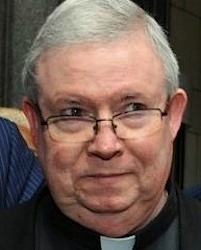 Catholic
priests — the first-ever trial of a diocesan
supervisor for allegedly covering up the scandal — has
opened in Philadelphia. The issue of
hierarchal responsibility is finally front and center. Catholic
priests — the first-ever trial of a diocesan
supervisor for allegedly covering up the scandal — has
opened in Philadelphia. The issue of
hierarchal responsibility is finally front and center.
Msgr. William Lynn (left),
the supervisor of Philadelphia priests for 12 years, is defending
himself from criminal conspiracy charges by alleging that culpability
for the scandal extended to the head of the archdiocese — via
a  secret
archive he compiled on predator priests that he said was ordered shredded
in 1994 by Cardinal Anthony Bevilacqua (right). secret
archive he compiled on predator priests that he said was ordered shredded
in 1994 by Cardinal Anthony Bevilacqua (right).
Whether the jury believes Monsignor Lynn’s contention that he
innocently did his duty by compiling the archive and handing it on
to his superiors is an open question. But its value in shedding light
on backroom maneuvering is already clear. A copy was found in a diocesan
safe six years ago and turned over to authorities this year as criminal
investigators looked into years of alleged rapes and other abuses
of schoolchildren. Cardinal Bevilacqua was expected to testify but
died earlier this year.
The trial is recapitulating painful aspects
of the nationwide scandal in which more than
700 priests had to be dismissed in a three-year period while the church’s
upper echelons faced no criminal charges. The trial unfolds
eight years after a review panel of laity appointed by the nation’s
bishops urgently warned that to repair the church’s reputation
“there must be consequences” for ranking church officials
who engineered cover-ups.
In the courtroom, a series of priests have testified for the prosecution
in obvious discomfort, telling of rogue colleagues merely being moved
among parishes by the diocese to avoid public scandal. One told of
how the diocese 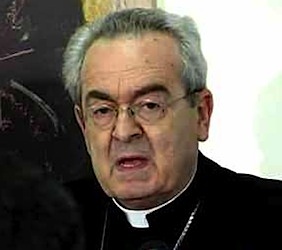 tried
to treat pedophile priests like alcoholics with “Sexaholics
Anonymous” programs. tried
to treat pedophile priests like alcoholics with “Sexaholics
Anonymous” programs.
Cardinal Justin Rigali (right) has
suspended two dozen priests since a grand jury severely criticized
him and reported that dozens of credibly accused
priests still remained in ministry despite
a proclaimed “zero tolerance” policy. Cardinal
Rigali has insisted the diocese was aggressive in rooting out bad
priests.
Catholic parishioners deserve the fullest possible accounting of the
scandalous abuse of their children. The trial of Monsignor Lynn is
a step in the right direction.
(Full
text)
|

FRANK BRUNI
|
Rethinking
His Religion
By FRANK BRUNI, OP-ED COLUMNIST
The New York Times: March 24, 2012
I MOVED
into my freshman-year dorm at the University of North Carolina after
 many
of the other men on the hall. One had already many
of the other men on the hall. One had already  begun
decorating. I spotted the poster above his desk
right away. It showed a loaf of bread and a chalice of red wine, with
these words: “Jesus invites you to a banquet
in his honor.” begun
decorating. I spotted the poster above his desk
right away. It showed a loaf of bread and a chalice of red wine, with
these words: “Jesus invites you to a banquet
in his honor.”
This man
attended Catholic services every Sunday in a jacket and tie, feeling
that church deserved such respect. I kept a certain distance from
him. I’d arrived at college determined to be honest about my
sexual orientation and steer clear of people who might make that uncomfortable
or worse. I figured him for one of them.
About two years ago, out of nowhere, he found me. His life,
he wanted me to know, had taken interesting turns. He’d gone
into medicine, just as he’d always planned. He’d married
and had kids. But he’d also strayed from his onetime script.
As a doctor, he has spent a part of his time
providing abortions.
I’m struck more than anything else by
how much searching and asking and reflecting he’s done,
this man I’d so quickly discounted, who pledged a fraternity
when he was still on my radar and then, when he wasn’t, quit
in protest over how it had blackballed a Korean pledge candidate and
a gay one.
Because we never really talked after freshman year, I didn’t
know that, nor did I know that after graduation he ventured to a desperately
poor part of Africa to teach for a year. College, he recently told
me, had not only given him a glimpse of how large the world was but
also shamed him about how little of it he knew.
In his 30s he read all 11 volumes of “The
Story of Civilization,” then tackled Erasmus, whose mention
in those books intrigued him. When he told me this I was floored:
I knew him freshman year as a gym rat more than a bookworm and extrapolated
his personality and future from there.
During our recent correspondence, he said he was sorry for any impression
he might have given me in college that he wasn’t open to the
candid discussions we have now. I corrected him: I owed the apology
— for misjudging him.
He grew up in the South, in a setting so homogenous and a family so
untroubled that, he said, he had no cause to question his parents’
religious convictions, which became his. He said that college gave
him cause, starting with me. Sometime
during freshman year, he figured out that I
was gay, and yet I didn’t conform to his prior belief that homosexuals
were “deserving of pity for their mental illness.” I
seemed to him sane and sound.
Questioning his church’s position on homosexuality made him
question more. He read the Bible “front to back and took
notes of everything I liked and didn’t like,” he said.
He also read books on church history and, he said, “was
appalled at the behavior of the church while it presumed to teach
all of us moral behavior.” How
often had it pushed back at important science? Vilified important
thinkers?
Even so, he added to his teaching duties in
Africa a weekly, extracurricular Bible study for the schoolchildren.
But the miseries he witnessed made him second-guess
the point of that, partly because they made him second-guess any god
who permitted them.
He saw cruelties born of the kind of bigotry that religion and false
 righteousness
sometimes abet. A teenage girl he met was dying of sepsis from
a female circumcision performed with a kitchen
knife. He asked the male medical worker attending to her why
such crude mutilation was condoned, and was told that women
otherwise were overly sexual and “prone
to prostitution.” righteousness
sometimes abet. A teenage girl he met was dying of sepsis from
a female circumcision performed with a kitchen
knife. He asked the male medical worker attending to her why
such crude mutilation was condoned, and was told that women
otherwise were overly sexual and “prone
to prostitution.”
“Isn’t it just possible,”
he pushed back, “that women are
prone to poverty, and men are prone to prostitution?”
He has thought a lot about how customs, laws and religion do and don’t
jibe with women’s actions and autonomy.
“In all centuries, through all history, women have ended pregnancies
somehow,” 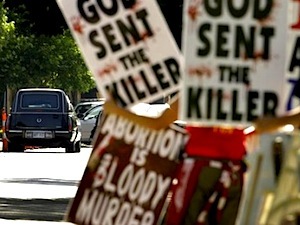 he
said. “They feel so strongly about this that they
will attempt abortion even when it’s illegal,
unsafe and often lethal.” he
said. “They feel so strongly about this that they
will attempt abortion even when it’s illegal,
unsafe and often lethal.”
He had researched and reflected on much of this by the time he graduated
from medical school, and so he decided to devote
a bit of each week to helping out in an abortion
clinic. Over years to come, in various settings, he
continued this work, often braving protesters,  sometimes
wearing a bulletproof vest. sometimes
wearing a bulletproof vest.
He knew George Tiller (left), the Kansas
abortion provider shot dead in 2009 by
an abortion foe.
 That happened in a church, he noted.
He hasn’t belonged to one since college. “Religion
too often demands belief in physical absurdities and anachronistic
traditions despite all scientific evidence and moral progress,”
he said.
That happened in a church, he noted.
He hasn’t belonged to one since college. “Religion
too often demands belief in physical absurdities and anachronistic
traditions despite all scientific evidence and moral progress,”
he said.
And in too many religious people he sees inconsistencies. They
speak of life’s preciousness when railing against abortion but
fail to acknowledge how they let other values override that concern
when they support war, the death penalty or governments that do nothing
for people in perilous need.
He has not raised his young children in any
church, or told them that God exists, because he no longer believes
that. But he wants them to have the community-minded values and altruism
that he indeed credits many religions with fostering. He wants them
to be soulful, philosophical.
So he rounded up favorite quotations from Emerson, Thoreau, Confucius,
 Siddhartha,
Gandhi, Marcus Aurelius, Martin Luther King Siddhartha,
Gandhi, Marcus Aurelius, Martin Luther King  and
more. From the New Testament, too. He put each
on a strip of paper, then filled a salad bowl with the strips.
At dinner he asks his kids to fish one out so they can discuss it. and
more. From the New Testament, too. He put each
on a strip of paper, then filled a salad bowl with the strips.
At dinner he asks his kids to fish one out so they can discuss it.
He takes his kids outside to gaze at stars,
which speak to the wonder of creation and the humility he wants them
to feel about their place in it.
He’s big on humility, asking, who are we to go to the barricades
for human embryos and then treat animals and their habitats with such
contempt? Or to make such unforgiving judgments about people who err,
including women who get pregnant without meaning to, unequipped for
the awesome responsibility of a child?
As a physician, he said, you’re privy to patients’ secrets
— to their truths — and understand that few people live
p to their own stated ideals. He has treated a philandering pastor,
a drug-abusing financier. “I see life as it really is,”
he told me, “not how we wish it were.”
He shared a story about one of the loudest abortion foes he ever encountered,
a woman who stood year in and year out on a ladder, so that her head
would be above other protesters’ as she shouted “murderer”
at him and other doctors and  “whore”
at every woman who walked into the clinic. “whore”
at every woman who walked into the clinic.
One day she was missing. “I thought, ‘I hope she’s
O.K.,’ ” he recalled. He walked into an examining room
to find her there. She needed an abortion and
had come to him because, she explained, he was a familiar face. After
the procedure, she assured him she wasn’t like all those other
women: loose, unprincipled.
She told him: “I
don’t have the money for a baby right now. And my relationship
isn’t where it should be.”
“Nothing like life,” he responded,
“to teach you a little more.”
A week later, she was back on her ladder.
|

GENERAL
JOHN STARK
"Live free or die: Death is not the worst of evils."
|
The
Church Lady State
By TIMOTHY EGAN
The New York Times: March 22, 2012
When
people complain about liberal overreach they always bring up the nanny
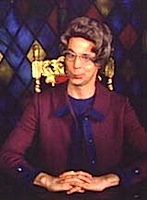 state.
You know, sorting your garbage to see if a banana peel slipped in with
a cellophane wrapper; energy-efficient light bulbs; neutered language
in the public square to make sure no one is ever offended. state.
You know, sorting your garbage to see if a banana peel slipped in with
a cellophane wrapper; energy-efficient light bulbs; neutered language
in the public square to make sure no one is ever offended.
But all of the above is a mere teardrop in the
Amazon compared to what your freedom-hating Republican
Party has been doing across the land to restrict
individual liberty.
They want the state to follow you into the bedroom, the bathroom and
beyond.
 There
is one recent exception, and it deserves praise. There
is one recent exception, and it deserves praise.  A
few days ago, the New Hampshire Legislature
voted overwhelmingly to keep a law that gives people of the same sex
the freedom to marry. Legislators decided,
in the kind of deliberation that stills the cynic in me,
that telling somebody whom they can or cannot marry is
the ultimate restriction on personal liberty. If your official
state motto is “Live Free or Die,”
you ought to act like you believe it. A
few days ago, the New Hampshire Legislature
voted overwhelmingly to keep a law that gives people of the same sex
the freedom to marry. Legislators decided,
in the kind of deliberation that stills the cynic in me,
that telling somebody whom they can or cannot marry is
the ultimate restriction on personal liberty. If your official
state motto is “Live Free or Die,”
you ought to act like you believe it.
They did.
Click
√ on Church Lady for more |

HENRIETTE
SASSON
|
French
horror hits home here
Jersey kin’s torment
By DAN MACLEOD
Post Wire Services: March 21, 2012

The senseless slaughter of three young children and a rabbi at a Jewish
school in France has the victims’ stunned relative in New Jersey
questioning her faith.
“It makes me revolt against God for what
happened,” said Henriette Sasson,
63, from her Saddle River home.
“I’m a believer, but after
seeing this, I ask myself, ‘Is there a God that can let these
things happen to innocent kids?’”
|
|
Billboards
saying God is “a myth” to go up in Jewish and Muslim
communities
Atheist group funding the billboards wants to
reach out to closeted atheists in religious communities
BY BRADEN GOYETTE
NEW YORK DAILY NEWS: March 3, 2012,
An atheist
group is putting up signs that say God is "a myth" -- and
they're making sure that Jews and Muslims will see them.

American
Atheists announced
on their website that two signs, one in Hebrew and one in Arabic,
will go up in Brooklyn and Paterson, New Jersey, this Monday.
The Hebrew sign will go up near the Williamsburg Bridge, where there
is a large orthodox Jewish community, CNN reported. The other, written
in Arabic and English, will go up just a few blocks from a Paterson
mosque, the Islamic Center of Passaic County.
The signs feature each faith's word for God in large lettering next
to the message "You know it's a myth...
and you have a choice."
American Atheists says on their website that the signs aren't intended
to offend, but are meant as outreach to atheists in those communities
who may "feel particularly alone." They're also supposed
to get the word out about the "Reason Rally"
the group is holding on Mar. 24 in Washington,
D.C.
Mohamed Elfilali, executive director of the Islamic Center of Passaic
County, was not particularly troubled by news of the billboards. "It
is not the first and won’t be the last time people have said
things about God or religion,” he told CNN. “I respect
people’s opinion about God; obviously they are entitled to it.
I don’t think God is a myth, but that doesn’t exclude
people to have a different opinion.”
The billboards will be up for a month and cost less than $15,000 each,
American Atheists president Dave Silverman
told CNN.
The group plans to put up similar signs in California and New York's
Chinatown, NorthJersey.com reported.
This isn’t the first time American Atheists have put up anti-religion
billboards in the New York area. In Nov. 2010, the group sponsored
a Christmas-themed billboard near the Lincoln Tunnel, with the words
"You KNOW it's a myth. This season, celebrate REASON!"
|
| |
Mayor
to Give $250,000 to Planned Parenthood
By MICHAEL PAULSON and KATE TAYLOR
The New York Times: February 2, 2012
Mayor Michael R. Bloomberg,
responding to the controversy over a breast cancer  advocacy
group that cut off most of its grants to Planned
Parenthood for breast cancer screening,
said Thursday that he would make up a large part of the missing money. advocacy
group that cut off most of its grants to Planned
Parenthood for breast cancer screening,
said Thursday that he would make up a large part of the missing money.
Mr. Bloomberg, a billionaire with a
long-term interest in public health, said
he would give Planned Parenthood Federation of America a $250,000
matching gift — he will donate $1 for every new dollar Planned
Parenthood raises up to $250,000.
“Politics have no place
in health care,”
he said in a statement. “Breast
cancer screening saves lives and hundreds of thousands of women rely
on Planned Parenthood for access to care. We should be helping women
access that care, not placing barriers in their way.”
Mr. Bloomberg then highlighted his contribution on Twitter, posting
a series of messages asking his followers to contribute to Planned
Parenthood.
The controversy erupted this week when the Susan
G. Komen for the Cure foundation said
it would not renew most of the grants it had been making to Planned
Parenthood for breast cancer screening. The Komen foundation
had been giving about $700,000 a year to Planned Parenthood.
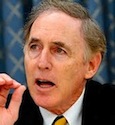
A Komen board member said on Wednesday
that the decision to cut off the contributions
was made because of the fear
that an investigation of Planned Parenthood by Representative
Cliff Stearns, Republican of Florida (right),
would damage Komen’s credibility with
donors.
Cecile Richards,
the president of the Planned Parenthood Federation of America, issued
a statement saying, “On behalf
of hundreds of thousands of women nationwide who rely on Planned Parenthood
for breast cancer education and screening, we are enormously grateful
to Mayor Bloomberg. This contribution will help ensure that politics
don’t interfere with women having access to health care. People
all across the country have stepped forward in the last 48 hours to
offer help and support, and the mayor’s donation will help ensure
that no woman is denied breast cancer services because of  right-wing
political pressure campaigns.” right-wing
political pressure campaigns.”
Mr. Bloomberg has been a longtime supporter
of both the Komen foundation and Planned Parenthood. According
to his office, he has given $555,000 to Planned Parenthood over the
years. And he has given $200,000 to
the Komen foundation, much of it in the form of matching
grants to Bloomberg L.P. employees who have run in the foundation’s
fund-raising road races.
(Full
text)
A
Painful Betrayal
EDITORIAL
The New York Times: February 2, 2012
With
its roster of corporate sponsors and the pink ribbons that lend a
halo to almost any kind of product you can think of,
the Susan G. Komen for the Cure foundation has a longstanding
reputation as a staunch protector of women’s health. That reputation
suffered a grievous, perhaps mortal, wound this week from the news
that Komen, the world’s largest breast cancer organization,
decided to betray that mission. It threw itself
into the middle of one of America’s nastiest political battles,
on the side of hard-right forces working to demonize Planned Parenthood
and undermine women’s health and freedom.
The
Associated Press reported on Tuesday that the foundation is cutting
off its financing of breast cancer screening and education programs
run by Planned Parenthood affiliates. That means nearly $700,000 less
for Planned Parenthood, which performed 750,000 such screenings last
year, many thousands of them with money from the Komen foundation.
Mayor Michael Bloomberg of New York pledged
to match up to $250,000 for Planned Parenthood, a generous move,
although it addresses only one year’s financing. There was also
an outpouring of support from small donors.
In addition to harming women, the foundation has also tarnished, perhaps
permanently, its brand, symbolized by the pink ribbon that adorns
yogurt cups and running shoes and tote bags and Federal Premium Ammunition’s
pink shotgun shells. Companies like Ford Motor, Dell and Yoplait may
not find the same value in identifying themselves with the foundation
after its sharp departure from political neutrality.
To try to justify its move, the foundation cited a new policy against
making grants to groups under federal or state investigation —
in Planned Parenthood’s case, an inquiry into how it spends
its taxpayer money by Representative Cliff Stearns,
a Republican of Florida. That is just a flimsy fig leaf.
Mr. Stearns’s “investigation”
is nothing more than a political witch hunt, stirred up by Republican
leaders and by a right-wing antichoice group, Americans United for
Life, which now displays the pink ribbon on its Web site as part of
a fund-raising campaign for Komen. The inquiry is part of the Republican
campaign to stigmatize Planned Parenthood and end financial support
for its invaluable network of clinics. Abortions make up only about
3 percent of its work, but most of this crowd also objects to its
leading role in providing access to contraceptives.
The Komen foundation should be speaking out against this abuse of
Congressional power. At the least, the foundation’s leaders
should have the decency and good sense not to do or say anything that
even implies an endorsement.
It’s not clear whether this move reflects
the political agenda of Komen’s leadership, including its new
senior vice president for public policy, Karen Handel, who called
for defunding Planned Parenthood during her failed gubernatorial campaign
in Georgia in 2010. Perhaps the foundation just caved in to
bullying by politicians, although it is not clear why it would have
unless it was sympathetic to their cause. Either way, the result is
the same: negative fallout for women’s health.
(Full
text)
Published
Commentary
@
RKimIndiana
Feb. 3, 2012
"Susan B. Anthony and Mary Wollstonecraft, two heroic
women who have done much to fight for equality, were also
against abortion."
 Regarding
Susan B. Anthony's abortion beliefs, Anthony scholar
Ann D. Gordon and Anthony biographer Lynn Sherr argue that
Anthony "spent no time on the politics
of abortion." * Just one more false, mendacious
claim by the religious right (a.k.a. social conservatives)
trying to Shanghai and twist history to their political advantage.
Those not interested in fact-checking, parrot. Regarding
Susan B. Anthony's abortion beliefs, Anthony scholar
Ann D. Gordon and Anthony biographer Lynn Sherr argue that
Anthony "spent no time on the politics
of abortion." * Just one more false, mendacious
claim by the religious right (a.k.a. social conservatives)
trying to Shanghai and twist history to their political advantage.
Those not interested in fact-checking, parrot.
* Gordon, Ann D.; Sherr, Lynn (May 21, 2010). "Sarah
Palin is no Susan B. Anthony". WashingtonPost.com, "On
Faith" blog. Retrieved October 22, 2010.
ROBERT
COANE, Feb. 3, 2012
|
|

LOUISE
M.ANTONY
|
Good
Minus God
By LOUISE M. ANTONY
THE NEW YORK TIMES: December 18, 2011
We “moralistic
atheists” do not see right and wrong as
artifacts of a divine protection racket. Rather,
we find moral value to be immanent in the natural
  world,
arising from the vulnerabilities of sentient beings and from the capacities
of rational beings to recognize and to respond to those vulnerabilities
and capacities in others. world,
arising from the vulnerabilities of sentient beings and from the capacities
of rational beings to recognize and to respond to those vulnerabilities
and capacities in others.
It is only if morality is independent
of God that we can make moral sense out of religious worship.
It is only if morality is independent of God that any person can have
a moral basis for adhering to God’s commands.
Think now about our personal relations — how we love our parents,
our children, our life partners, our friends. To say that the
moral worth of these individuals depends on the existence of God is
to say that these people are, in themselves, worth nothing —
that the concern we feel for their well being has no more ethical
significance than the concern some people feel for their boats or
their cars. It is to say that the historical connections we
value, the traits of character and personality that we love —
all count for nothing in themselves. Other people warrant our
concern only because they are valued by someone else — in this
case, God. (Imagine telling a
child: “You are not inherently lovable. I love you only
because I love your father, and it is my duty to love anything he
loves.”)
What could make anyone think such things? Ironically, I think
the answer is: the same picture of morality that lies behind atheistic
nihilism. It’s the view that the only kind of “obligation”
there could possibly be is the kind that is disciplined by promise
of reward or threat of punishment. Such a view cannot find or
comprehend any value inherent in the nature of things, value that
could warrant particular attitudes and behavior on the part of anyone
who can apprehend it.
 Divine
Command Theory insists both that there is such a thing as moral goodness,
and that it is defined by what God commands. This makes for really
appalling Divine
Command Theory insists both that there is such a thing as moral goodness,
and that it is defined by what God commands. This makes for really
appalling  consequences,
from an intuitive, moral point of view. Divine Command Theory entails
that anything at all could be “good” or “right”
or “wrong.” If God were to command you to eat your children,
then it would be “right” to eat your children. consequences,
from an intuitive, moral point of view. Divine Command Theory entails
that anything at all could be “good” or “right”
or “wrong.” If God were to command you to eat your children,
then it would be “right” to eat your children.
God is extremely powerful, and so can make us suffer if we disobey
Him, but the same can be said of tyrants, and we have no moral obligation
(speaking now in ordinary terms) to obey tyrants. (We might
even have a moral obligation to disobey tyrants.) The same goes
for worshipping God. We might find it in our interest to flatter
or placate such a powerful person, but there could be no way in which
God was deserving of praise or tribute.
If “good” is to have normative
force, it must be something that we can understand independently of
what is commanded by a powerful omnipresent being.
You do not lose morality by
giving up God; neither do you necessarily find it by finding Him.
I want to close by conceding that there are things one loses in giving
up God, and they are not insignificant. Most importantly, you
lose the guarantee of  redemption.
Suppose that you do something morally terrible, something for which
you cannot make amends, something, perhaps, for which no human being
could ever be expected to forgive you. I imagine that the promise
made by many religions, that God will forgive you if you are truly
sorry, is a thought would that bring enormous comfort and relief.
You cannot have that if you are an atheist. In consequence,
you must live your life, and make your choices with the knowledge
that every choice you make contributes, in one way or another, to
the only value your life can have. redemption.
Suppose that you do something morally terrible, something for which
you cannot make amends, something, perhaps, for which no human being
could ever be expected to forgive you. I imagine that the promise
made by many religions, that God will forgive you if you are truly
sorry, is a thought would that bring enormous comfort and relief.
You cannot have that if you are an atheist. In consequence,
you must live your life, and make your choices with the knowledge
that every choice you make contributes, in one way or another, to
the only value your life can have.
Some people think that if atheism
were true, human choices would be insignificant. I think just
the opposite — they would become surpassingly important.
ILLUSTRATION
PAINTINGS |
Francisco
de Goya y Lucientes:
Saturn Devours His Children |
Michelangelo
Merisi da Caravaggio:
Sacrifice of Isaac |
(Full
text)
|
|
Mississippi
Voters Reject Anti-Abortion Measure
By KATHARINE Q. SEELYE
The New York Times: November 8, 2011
Voters turned a skeptical eye toward conservative-backed measures
across the country Tuesday, rejecting
an anti-labor law in Ohio, an anti-abortion
measure 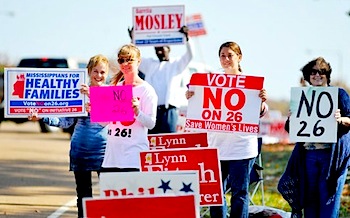 in
Mississippi and a crackdown on voting rights in Maine. in
Mississippi and a crackdown on voting rights in Maine.
[Voters]in Mississippi,
one of the most conservative states, turned
away a measure that would have outlawed all
abortions and many forms of contraception and had drawn conservative
support from members of both parties.
...in Iowa,
Republicans failed in their attempt to
win control of the State Senate. Had
they won a special election there, they would have likely been able
to pass numerous measures, including a ban on
same-sex marriage, that had been blocked by Democrats.
In one of the biggest surprises of the
night was Mississippi’s rejection of a far-reaching and stringent
anti-abortion initiative known as the “personhood”
amendment, which had inspired a ferocious national
debate.
Initiative
26 would have amended the state Constitution to define life
“to include every human being from the
moment of fertilization, cloning or the functional equivalent thereof.”
Supporters, including evangelical
Christians, said it would have stopped the
murder of innocent life and sent a clarion moral call to the world.
They said they expected that passage
in Mississippi would have built support for similar laws in other
states.
Opponents, led by Planned
Parenthood and the American Civil Liberties
Union, said the proposal would have outlawed
all abortions, including in cases of rape and incest and when the
mother’s life was in danger; would have barred morning-after
pills and certain contraception such as IUD’s; and could have
limited in vitro fertility procedures.
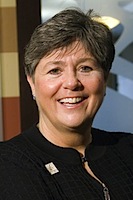 “The
message from Mississippi is clear,” Nancy
Keenan, president of NARAL Pro-Choice America, said in a statement.
“An amendment that allows politicians to further interfere in
our personal, private medical decisions, including a woman’s
right to choose safe, legal abortion, is unacceptable.” “The
message from Mississippi is clear,” Nancy
Keenan, president of NARAL Pro-Choice America, said in a statement.
“An amendment that allows politicians to further interfere in
our personal, private medical decisions, including a woman’s
right to choose safe, legal abortion, is unacceptable.”
The push for a personhood amendment
split the country’s anti-abortion movement. Traditional leaders
including the Roman Catholic bishops
and National Right to Life opposed it
on strategic grounds,
fearing it would lead to a United States Supreme Court defeat and
set back to their efforts to chip away at abortion rights.
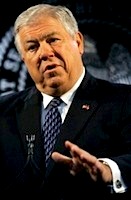
Governor Barbour
is a strong opponent of abortion rights but expressed skepticism about
the amendment’s wording.
“It’s unnecessarily ambiguous,” he told MSNBC on
Tuesday. He also criticized the strategy of sending it to voters rather
than to the Legislature — a blunder
he attributed to people in Colorado, who wrote the measure
— and said it would not be a good test case with which to try
to overturn Roe v. Wade,
the 1973 Supreme Court decision that legalized abortion. Nonetheless,
Mr. Barbour said, he had supported the measure because he believes
that life begins at conception.
Back
to Common Sense at the Polls
EDITORIAL
Published: November 9, 2011
But,
even the voters in that state, one of the country’s most conservative,
decisively rejected an amendment to ban abortion by declaring a fertilized
egg as a person. The measure also would have effectively banned some
forms of contraception and even in-vitro fertilization, and 58 percent
of voters said that was going too far.
Wait!
Don’t Tell Me!
By GAIL COLLINS, OP-ED COLUMNIST
The New York Times: November 9, 2011
And,
in Mississippi, voters resoundingly rejected an anti-abortion amendment
that would have made every fertilized egg a person.
Things have gone so far that Mississippi has to pull us back.
The personhood proposal didn’t come up during the debate. The
pack-trailing Jon Huntsman has been the only Republican candidate
who’s said he thought it went too far. In a Fox interview, Romney
danced around the edges. When asked, “Would you have supported
the constitutional amendment that would have established the definition
of life at conception?” Mitt said: “Absolutely.”
|
|
The
Netherlands: New System to Compensate Abuse Victims
THE ASSOCIATED PRESS : November 7, 2011
 The
Dutch branch of the Roman Catholic Church
will start a compensation system The
Dutch branch of the Roman Catholic Church
will start a compensation system  that
clears the way for victims of abuse by priests and other church workers
to receive payments of up to $138,000, the church
announced Monday. The country’s
Bishops’ Conference and Conference
of Religious Orders said the system would probably take effect
next month. Thousands of cases of allegations of sexual
abuse by Dutch priests are under investigation by an independent,
church-financed commission. that
clears the way for victims of abuse by priests and other church workers
to receive payments of up to $138,000, the church
announced Monday. The country’s
Bishops’ Conference and Conference
of Religious Orders said the system would probably take effect
next month. Thousands of cases of allegations of sexual
abuse by Dutch priests are under investigation by an independent,
church-financed commission.
(Full
text)
|
|
Catholic
Paper Apologizes for Homosexuality Column
By LAURIE GOODSTEIN
Thed New York Times: November 3, 2011
The official newspaper of the Roman Catholic archdiocese of Boston
has 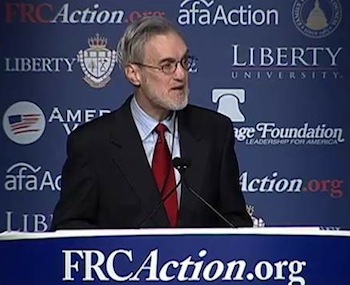 apologized
for a column that said that homosexuality is caused by Satan.
The column’s author, Daniel Avila,
is a lawyer and policy adviser at the Catholic
bishops’ conference in Washington, where he works in
the office that opposes the spread of same-sex marriage.
Mr. Avila wrote, “The
scientific evidence of how apologized
for a column that said that homosexuality is caused by Satan.
The column’s author, Daniel Avila,
is a lawyer and policy adviser at the Catholic
bishops’ conference in Washington, where he works in
the office that opposes the spread of same-sex marriage.
Mr. Avila wrote, “The
scientific evidence of how  same-sex
attraction most likely may be created provides a credible basis for
a spiritual explanation that indicts the devil.”
The church’s Boston newspaper,
The Pilot, apologized for “having
failed to recognize the theological error in the column before publication,”
and it deleted the column from its Web site. A
spokeswoman for the bishops’ conference said that
Mr. Avila’s column was not approved by the bishops, and that
the church does not have a definitive theory on the origins of same-sex
attraction. same-sex
attraction most likely may be created provides a credible basis for
a spiritual explanation that indicts the devil.”
The church’s Boston newspaper,
The Pilot, apologized for “having
failed to recognize the theological error in the column before publication,”
and it deleted the column from its Web site. A
spokeswoman for the bishops’ conference said that
Mr. Avila’s column was not approved by the bishops, and that
the church does not have a definitive theory on the origins of same-sex
attraction.
(Full
text)
Illustration
above right: Gustave Doré from PARADISE LOST,1866
|
|
Ireland
Will Close Embassy to Vatican
By DOUGLAS DALBY
The New York Times: November 3, 2011
The government said Thursday that it
would close its embassy to the Vatican,  but
Deputy Prime Minister Eamon Gilmore (right)
said the decision was made on “purely economic grounds”
and not as a result of a rift with the Holy See over the handling
of allegations of child sexual abuse. Mr. Gilmore
said “recent controversies” had no bearing on the decision,
citing the government’s need to reduce expenses under the terms
of a European Union bailout package. The government is also closing
embassies in East Timor and Iran, he said. The
Vatican withdrew its ambassador to Ireland in July after an Irish
government report said the Vatican had discouraged bishops from reporting
cases of sexual abuse to the police, a charge the Vatican rejects.
The Vatican said Thursday that every state was “free to decide”
whether or not to have an envoy in Rome, but what counts are diplomatic
relations, “and these are not in question with regards to Ireland.” but
Deputy Prime Minister Eamon Gilmore (right)
said the decision was made on “purely economic grounds”
and not as a result of a rift with the Holy See over the handling
of allegations of child sexual abuse. Mr. Gilmore
said “recent controversies” had no bearing on the decision,
citing the government’s need to reduce expenses under the terms
of a European Union bailout package. The government is also closing
embassies in East Timor and Iran, he said. The
Vatican withdrew its ambassador to Ireland in July after an Irish
government report said the Vatican had discouraged bishops from reporting
cases of sexual abuse to the police, a charge the Vatican rejects.
The Vatican said Thursday that every state was “free to decide”
whether or not to have an envoy in Rome, but what counts are diplomatic
relations, “and these are not in question with regards to Ireland.”
(Full
text)
|

ARCHDIOCESE
of
KANSAS CITY
ST. JOSEPH
|
Bishop
Indicted; Charge Is Failing to Report Abuse
By A. G. SULZBERGER and LAURIE GOODSTEIN
The New York Times: October 14, 2011
KANSAS CITY, Mo. — A
bishop in the Roman Catholic Church has been 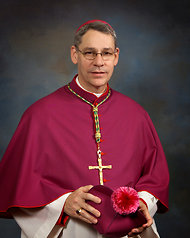 indicted
for failure to report suspected child abuse, the first time in the
25-year history of the church’s sex abuse scandals that the
leader of an American diocese has been held criminally liable for
the behavior of a priest he supervised. indicted
for failure to report suspected child abuse, the first time in the
25-year history of the church’s sex abuse scandals that the
leader of an American diocese has been held criminally liable for
the behavior of a priest he supervised.
The indictment of the bishop, Robert
W. Finn (left),
and the Diocese of Kansas City-St. Joseph
by a county grand jury was announced on Friday. Each
was charged with one  misdemeanor
count involving a priest accused of taking pornographic photographs
of girls as recently as this year. They pleaded not
guilty. misdemeanor
count involving a priest accused of taking pornographic photographs
of girls as recently as this year. They pleaded not
guilty.
The case caused an uproar among Catholics in Kansas City this year
when Bishop 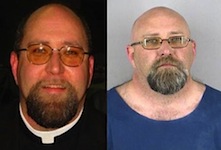 Finn
acknowledged that he knew of the photographs last December but did
not turn them over to the police until May. During
that time, the priest, the
Rev. Shawn Ratigan, is said to have continued to attend church
events with children, and took lewd photographs of another young girl. Finn
acknowledged that he knew of the photographs last December but did
not turn them over to the police until May. During
that time, the priest, the
Rev. Shawn Ratigan, is said to have continued to attend church
events with children, and took lewd photographs of another young girl.
A decade ago the American bishops pledged to report suspected abusers
to law enforcement authorities — a policy also recommended last
year by the Vatican. Bishop Finn himself
had made such a promise three years ago as part of a $10 million legal
settlement with abuse victims in Kansas City.
Though the charge is only a misdemeanor, victims’ advocates
immediately hailed the indictment as a breakthrough, saying that until
now American bishops have avoided prosecution despite documents showing
that in some cases they were aware of abuse.
 “This
is huge for us,” said Michael Hunter,
director of the Kansas City chapter of the Survivors
Network of those Abused by Priests, and a victim
of sexual abuse by a priest. “It’s something that I personally
have been waiting for years to see, some real accountability. We’re
very pleased with the prosecuting attorney here to have the guts to
do it.” “This
is huge for us,” said Michael Hunter,
director of the Kansas City chapter of the Survivors
Network of those Abused by Priests, and a victim
of sexual abuse by a priest. “It’s something that I personally
have been waiting for years to see, some real accountability. We’re
very pleased with the prosecuting attorney here to have the guts to
do it.”
The
bishop signaled he would fight the charges with all
his strength. He said in a statement:
“We will meet these announcements with a steady resolve and
a vigorous defense."
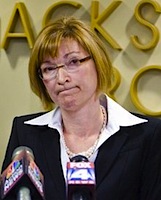
The
indictment announced on Friday by the Jackson
County prosecutor, Jean Peters Baker (right),
had been under seal since Oct. 6 because the bishop was out of the
country. He returned on Thursday night.
In a news conference, Ms. Baker said
the case was not religiously motivated, but was about the obligation
under state law to report child abuse.
“This is about protecting children,”
she said.

ARCHDIOCESE
of
KANSAS CITY
ST. JOSEPH
Accountability
in Missouri
EDITORIAL
The New York Times: October 20, 2011
It has
been seven years since the Roman Catholic Church’s investigative
board of laity warned that, beyond the 700 priests dismissed for sexually
abusing children, “there must be consequences” for the
diocesan leaders who recycled criminal priests through unsuspecting
parishes. American church authorities have done nothing to heed this
caution.
Now state prosecutors in Missouri have shown
the courage the prelates lacked.
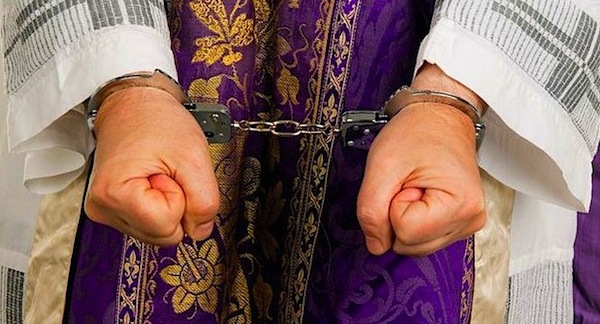
They
indicted Bishop Robert Finn (below
right) of the Diocese of Kansas
City - St. Joseph for allegedly failing to notify criminal
authorities about a popular parish priest who is accused of taking
pornographic photographs of young parochial schoolgirls — despite
community alarms and evidence submitted to the diocese.
Bishop Finn, who professed his innocence under the indictment, had
previously outraged church faithful by acknowledging that he knew
of the photos last  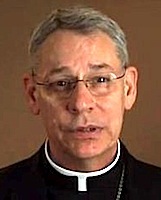 December
but did not turn them over to the police until May. December
but did not turn them over to the police until May.
This occurred despite the requirements of state law — and the
bishop’s own policy vows — that suspected crimes against
children be immediately reported. The priest, the Rev.
Shawn Ratigan (left),
continued to attend church events and allegedly abuse children until
he was indicted this year on 13 counts of child pornography.
Bishop Finn is only the first ranking prelate in the nationwide scandal
to be held criminally liable for the serial misbehavior of a priest
in his diocese. Investigations have shown that many more diocesan
officials across the country worked assiduously to bury the scandal
from public view over the years, despite continuing damage inflicted
on thousands of innocent youngsters.
In 2004, the nation’s bishops promised unqualified cooperation
with law enforcement. They instituted zero-tolerance reforms for priests
but failed to create a credible process for bringing bishops to account.
Missouri officials deserve credit for puncturing the myth that church
law and a bishop’s authority can somehow take precedence over
criminal law
— and the safety of children.
(Full
text)
|

SOMALIA
|
In
Rare Rally, Somalis Aim at Militants
By MOHAMED IBRAHIM and JEFFREY GETTLEMAN
The New York Times: October 9, 2011
MOGADISHU, Somalia — Thousands of
residents of this bul let-scarred city   packed
into a stadium on Sunday to denounce the Shabab
Islamist group for the suicide bombing last week that killed
scores of people, many of them students. packed
into a stadium on Sunday to denounce the Shabab
Islamist group for the suicide bombing last week that killed
scores of people, many of them students.
It was one of the largest rallies in years in Mogadishu, Somalia’s
capital.
Many participants cried as politicians and others took turns heaping
scorn on the Shabab, the
militant group that claimed responsibility for Tuesday’s truck
bombing.
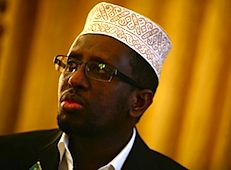 “Should
we abandon our country because of fugitive criminals from abroad and
children who have disobeyed their parents?” asked President
Sheik Sharif Sheik Ahmed (right).
“The answer is no.” “Should
we abandon our country because of fugitive criminals from abroad and
children who have disobeyed their parents?” asked President
Sheik Sharif Sheik Ahmed (right).
“The answer is no.”
The rally was held around noon on a steamy day. Many  people
were soaked in sweat by the time they walked from their neighborhoods
to the old soccer stadium, located in central Mogadishu. The program
included speeches and traditional Somali dances. Many people seemed
deeply moved. people
were soaked in sweat by the time they walked from their neighborhoods
to the old soccer stadium, located in central Mogadishu. The program
included speeches and traditional Somali dances. Many people seemed
deeply moved.
“I came here to denounce the Shabab’s
massacre on the students,” said Halima
Ulusow, an elderly woman whose face was wet with tears.
“We have to oppose all the bad culture
imported to our country by the Shabab.”
|
|
Bruce
MacKinnon
Halifax Chronicl-Herald
7 October 2011
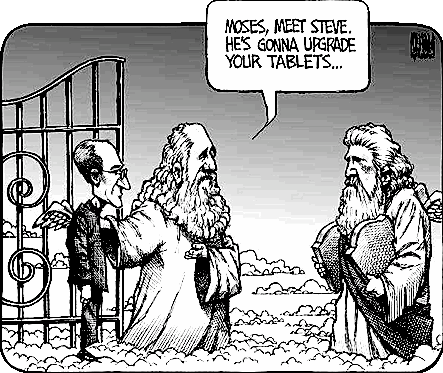
|
|
Catholic
Order Settles Sexual Abuse Suit for $17 Million
By IAN AUSTEN
The New York Times: October 6, 2011
Canada: After initially denying allegations of sexual
abuse at three Quebec  schools
it operated, a Roman
Catholic order said Thursday that it had settled a class-action
lawsuit by the victims with a $17 million
payment. In addition to the payment, the
Congregation of the Holy Cross issued
a formal apology. The
settlement covers incidents from 1950 to 2001, mostly at an elite
Montreal boarding school [College Notre-Dame] formerly run
by the order, which also controls the University of
Notre Dame in Indiana. A separate criminal investigation by the police
is continuing. schools
it operated, a Roman
Catholic order said Thursday that it had settled a class-action
lawsuit by the victims with a $17 million
payment. In addition to the payment, the
Congregation of the Holy Cross issued
a formal apology. The
settlement covers incidents from 1950 to 2001, mostly at an elite
Montreal boarding school [College Notre-Dame] formerly run
by the order, which also controls the University of
Notre Dame in Indiana. A separate criminal investigation by the police
is continuing.
(Full
text)
|

SAUDI
ARABIA
|
Saudi
Arabia woman, Shaima Jastaina, spared 10 lashes for driving: Princess
Amira al-Taweel
BY MICHAEL SHERIDAN
The New York Daily News: Thursday, September 29th 2011
A woman in Saudi Arabia will be spared
a whipping for driving a car, a member of the royal family says.
King Abdullah
has "canceled" a judge's order that Shaima
Jastaina get 10   lashes
for violating the country's ban on female drivers, according to <
Princess Amira al-Taweel,> wife of Saudi
Prince Alwaleed bin Talal. lashes
for violating the country's ban on female drivers, according to <
Princess Amira al-Taweel,> wife of Saudi
Prince Alwaleed bin Talal.
"Thank gød, the lashing
of Shaima is canceled," she wrote via Twitter
on Wednesday. "Thanks to our beloved
King. I'm sure all Saudi women will be so happy, I know I am."
She also wrote, "It
is official, Prince Alwaleed just confirmed it to me."
Afterwards, the princess said she and the prince spoke with Jastaina,
and quoted her as saying, "The
King's orders washed the fears I lived with after this unjust sentence."
No government official has publicly corroborated the Princess' claim,
however. One official told MSNBC that it was true, but spoke on the
condition of 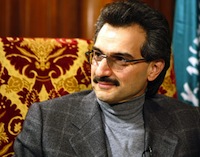 anonymity
because he was not authorized to talk to the media. anonymity
because he was not authorized to talk to the media.
Prince Alwaleed
(right), who
had been fighting to stop the lashings, later told Forbes
via text message, "I lobbied the
government and the king all the way ... The reform path moves on,
regardless of some voices here and there.
Jastaina, believed to be in her 30s, was sentenced on Monday to the
whipping.
The order came just a day after Abdullah announced that women would
be allowed to vote and hold elected office for the first time, starting
in 2015.
Saudi Arabia is the only nation in the world to ban women from driving,
whether they are Saudi or not. As a result, women rely on hired drivers,
which can cost families hundreds of dollars a month.
(Full
text)
• • •
Saudi
king annuls lashing female drivers
Ahlul Bayt News Agency / Associated Press: September 29 , 2011
A Saudi government official announced
the monarch's decision on Wednesday   without
offering further details. without
offering further details.
The King made the decision after a Jeddah
court sentenced Shaima Jastaina
to 10 lashes for defying the kingdom's ban on female drivers.
Saudi Arabia is the only country in the world that bans female drivers.
Contrary to some press reports by Western media, the
ban has no Islamic basis and reflects radical
interpretations of Wahhabi clerics that guide
the US-backed Saudi kingdom.
 The
sentence took Saudi women by surprise, two days after King
Abdullah (right) announced that women would be allowed
to vote for the first time in 2015. However, there is no national
voting in Saudi Arabia. Furthermore, women
still do not have the right to vote or run as candidates in new municipal
elections on Thursday, the second in the kingdom's history. The first
were held in 2005. The
sentence took Saudi women by surprise, two days after King
Abdullah (right) announced that women would be allowed
to vote for the first time in 2015. However, there is no national
voting in Saudi Arabia. Furthermore, women
still do not have the right to vote or run as candidates in new municipal
elections on Thursday, the second in the kingdom's history. The first
were held in 2005.
Amnesty International (AI)
has condemned the verdict, describing it as  “discrimination
against women in the kingdom.” “discrimination
against women in the kingdom.”
 “Flogging
is a cruel punishment in all circumstances but it beggars belief that
the authorities in Saudi Arabia have imposed lashes on a woman apparently
for merely driving a car,” said
Philip Luther, the Amnesty's Middle East
and North Africa deputy director. “Flogging
is a cruel punishment in all circumstances but it beggars belief that
the authorities in Saudi Arabia have imposed lashes on a woman apparently
for merely driving a car,” said
Philip Luther, the Amnesty's Middle East
and North Africa deputy director.
Saudi human rights groups also say the verdict is a payback for allowing
women to take part in elections.
In addition to driving prohibition, women in Saudi Arabia must have
written approval from a male guardian, which could be a father, husband,
brother or son, to leave the country, work or even undergo certain
medical operations.
|
|
Retailers
Are Put on the Spot Over Anti-Gay Aid
By ERIK ECKHOLM
The New York Times: September 25, 2011
The culture war over gay rights has entered
the impersonal world of e-commerce.
A handful of advocates, armed with nothing
more than their keyboards, have put many of the country’s largest
retailers, including Apple, Microsoft, Netflix
and Wal-Mart, on the spot over their indirect and, until recently,
unnoticed roles in funneling money to Christian
groups that are vocal in opposing homosexuality.
The advocates are demanding that the retailers end their association
with an Internet marketer that gets a commission from the retailers
for each online customer it gives them. It is a routine arrangement
on hundreds of e-commerce sites, but with a twist here:
a share of the commission that retailers pay is donated to a Christian
charity of the buyer’s choice, from a list that includes
prominent conservative evangelical groups like the Family
Research Council and Focus on the Family.
The marketer and
the Christian groups are fighting back, saying
that the hundred or so companies that have dropped the marketer were
misled and that the charities are being slandered
for their religious beliefs.
 The
national battle was ignited in July by Stuart
Wilber, a 73-year-old gay man in Seattle. He
was astonished, he said, when he learned that people who bought Microsoft
products through a Christian-oriented Internet marketer known as Charity
Giveback Group, or CGBG, could channel a donation to evangelical organizations
that call homosexual behavior a threat to the moral and social fabric. The
national battle was ignited in July by Stuart
Wilber, a 73-year-old gay man in Seattle. He
was astonished, he said, when he learned that people who bought Microsoft
products through a Christian-oriented Internet marketer known as Charity
Giveback Group, or CGBG, could channel a donation to evangelical organizations
that call homosexual behavior a threat to the moral and social fabric.
“I said, ‘You’ve got
to be kidding, Microsoft,’”
he recalled, noting that the software giant — like many other
corporations accessible through the commerce site, including Apple and
Netflix — was known as friendly
to gay causes.
In July, Mr. Wilber went to a Web site
that helps groups and individuals circulate petitions,
called Change.org, and
started one, asking Microsoft to end its association with what he called
“hate groups.” By that night,
520 people had signed, with their ire copied to Microsoft officials
— and Microsoft had quietly dropped out of the donation plan.
Much to Mr. Wilber’s surprise, this would be the start of an electronic
conflict that has put hundreds of well-known companies in an unwelcome
glare.
“This is economic terrorism,”
said Mike Huckabee, the former
pastor, governor  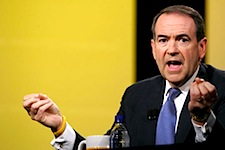 and
presidential contender, who is a paid CGBG consultant.
“To try to destroy a business because you don’t like some
of the customers is, to me, unbelievably un-American,” he said
in an interview. and
presidential contender, who is a paid CGBG consultant.
“To try to destroy a business because you don’t like some
of the customers is, to me, unbelievably un-American,” he said
in an interview.
CGBG, a for-profit
company formerly called the Christian Values Network,
resembles hundreds of so-called affiliate marketers, which retailers
use to bring customers to their own Web sites. The affiliate receives
a commission on any sales, and CGBG
allows buyers to send half that commission to any of the Christian
charities on its list. |

IRELAND

|
Rupture
With Vatican Reveals a Changed Ireland
By SARAH LYALL
The New York Times: September 18, 2011
DUBLIN — Ireland is in the midst
of a profound transformation, as rapid as it is revolutionary: it
is recalibrating its relationship to the Roman Catholic Church, an
institution that has permeated almost every aspect of life here for
generations.
This is still a country where abortion is against the law, where divorce
became legal only in 1995, where the
church runs more than 90 percent of the primary schools
and where 87 percent of the population identifies itself as Catholic.
But the awe, respect and fear the Vatican
once commanded have given way to something new —
rage, disgust and defiance — after a long series of horrific
revelations about decades of abuse of children entrusted to the church’s
care by a reverential populace.
While similar disclosures have tarnished the Vatican’s image
in other  countries,
perhaps nowhere have they shaken a whole society so thoroughly or
so intensely as in Ireland. And so when the normally mild-mannered
prime minister, Enda Kenny (right),
unexpectedly took the floor in Parliament this summer to criticize
the church, he was giving voice not just to his own
pent-up feelings, but to those of a nation. countries,
perhaps nowhere have they shaken a whole society so thoroughly or
so intensely as in Ireland. And so when the normally mild-mannered
prime minister, Enda Kenny (right),
unexpectedly took the floor in Parliament this summer to criticize
the church, he was giving voice not just to his own
pent-up feelings, but to those of a nation.
His remarks were a ringing declaration of the supremacy of state over
church, in words of outrage and indignation that 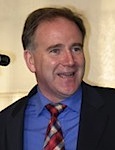 had
never before been used publicly by an Irish leader. The effect of
his speech was instant and electric. had
never before been used publicly by an Irish leader. The effect of
his speech was instant and electric.
“It was
a seminal moment,” said Patsy McGarry
(left), the religious affairs correspondent for The
Irish Times. “No Irish prime minister
has ever talked to the Catholic Church before in this fashion. The
obsequiousness of the Irish state toward the Vatican is gone. The
deference is gone.”
 There is no question that Mr. Kenny’s declaration deeply angered
the Vatican. It immediately withdrew
its ambassador from Dublin, Archbishop Giuseppe
Leanza (left),
ostensibly to help fashion the Vatican’s formal response. (The
ambassador has since been reassigned to the Czech Republic.)
There is no question that Mr. Kenny’s declaration deeply angered
the Vatican. It immediately withdrew
its ambassador from Dublin, Archbishop Giuseppe
Leanza (left),
ostensibly to help fashion the Vatican’s formal response. (The
ambassador has since been reassigned to the Czech Republic.)
Mr. Kenny, who took
office in March after the long-dominant Fianna Fail party imploded
over the financial crisis, has been
accused of opportunism by some critics. But
his position as a practicing Catholic from a conservative area helped
give moral weight to his speech. And his government’s feisty
new tone has been met with widespread approval in a place that feels
doubly betrayed: first by the abuse itself, and second by what many
see as a cover-up by the church, compounded by the often opaque, legalistic
language with which it 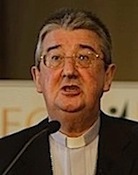 defends
itself. defends
itself.
While most people have not abandoned their religion, many seem to
have abandoned the habit of practicing it. The
archbishop of Dublin, Diarmuid Martin (right),
recently estimated that only 18 percent of the Catholics in his archdiocese
attended Mass every week.
The government has announced that it
will introduce a package of new legislation
to protect children from abuse and neglect, including a law
— considered but rejected as too contentious by previous governments
— that would make it mandatory to report
evidence of crimes to the authorities.
It
has also established a group to examine how to remove half of the
country’s Catholic primary schools from church control.
Eamon Gilmore
(right),
Ireland’s deputy prime minister, said that Ireland had asserted
 its
role as a “modern democracy.” its
role as a “modern democracy.”
No longer would the church enjoy its previous
privileges and powers as in times past, when it, with the government’s
collusion, “effectively dictated the social
policy of the state,” he said.
“Historically, there was a view
within the Catholic Church that there was a parallel law, that they
had their own system of law, and that was the law to which they were
accountable,” Mr. Gilmore said.
“At a minimum, that blurred the understanding
of the necessity for full compliance with the law of the state.”
He added: “The Catholic Church
is perfectly entitled to have its own view and its own rule and to
view matters according to its own light. But
this is a republic. And there is one law.”
When it comes to protecting children,
Mr. Gilmore said, “Everybody in the state
— irrespective of whether they’re ordinary citizens doing
everyday work, or a priest or a bishop — has to comply with
the law.”
|
|
Politicians
Open Front on Abortion in Bay Area
By JESSE McKINLEY
The New York Times: August 3, 2011
SAN
FRANCISCO — Seeking to stem what they call misleading advertising,
San Francisco officials on Tuesday began a two-pronged attack on “crisis
pregnancy centers,” which are billed as places for pregnant women
to get advice, but often use counseling to discourage abortions.
The first element was a bill introduced to the city’s Board of
Supervisors  that
would make it illegal for such centers to advertise falsely about their
pregnancy-related services, something already more broadly covered by
a state law barring deceptive advertising. But
the bill’s author, Malia Cohen (right),
said the law was necessary to protect low-income women who are
drawn into the centers, which often offer free services. that
would make it illegal for such centers to advertise falsely about their
pregnancy-related services, something already more broadly covered by
a state law barring deceptive advertising. But
the bill’s author, Malia Cohen (right),
said the law was necessary to protect low-income women who are
drawn into the centers, which often offer free services.
“As a city, we have a responsibility
to protect our most vulnerable residents,”
said Ms. Cohen, who accused the centers of pushing “anti-abortion
propaganda and mistruths on unsuspecting women.”
At the same time, Dennis
Herrera (left),
the San Francisco city attorney, said his  office
had written to a local center, First Resort,
about its advertisements, which he said “appear
to be designed to confuse or mislead consumers.”
In a letter to the center’s chief office
had written to a local center, First Resort,
about its advertisements, which he said “appear
to be designed to confuse or mislead consumers.”
In a letter to the center’s chief
 executive,
Shari Plunkett (right),
Mr. Herrera asked that the ads be corrected to
make clear that the center does not perform abortions or make referrals
for them. executive,
Shari Plunkett (right),
Mr. Herrera asked that the ads be corrected to
make clear that the center does not perform abortions or make referrals
for them.
Mr. Herrera, a Democrat and a candidate
for mayor, was also explicit in his distaste for the centers, calling
them “right wing, politically motivated”
institutions whose mission was “to dissuade women from seeking
their constitutionally protected rights.”
First Resort,
a nonprofit corporation whose statement of purpose says it is a Christian
group devoted to “an abortion-free world,” advertises
its centers as offering “counseling and
medical care to women who are making decisions about unplanned pregnancies.”
In a statement, Ms. Plunkett denied that her advertising was misleading
and said that all First Resort clients had “full disclosure on
the types of services we provide.” |
|
Panel
Approves Measure Banning Face Coverings
  By
GAIA PIANIGIANI By
GAIA PIANIGIANI
The New York Times: August 2, 2011
Italy - An
Italian parliamentary commission passed a draft law on Tuesday to
ban women from wearing clothing that covers their faces in public.
The draft would prohibit women from wearing any garment, including
the burqa (left) and
niqab (right),
that covers the face and makes it hard to recognize them in public.
Under the proposed legislation, anyone
forcing women to cover their faces would be fined
and face up to 12 months in jail.
(Full text)
|
|
Atheists
Sue to Block Display of Cross-Shaped Beam in 9/11 Museum
By ELISSA GOOTMAN
The New York Times: July 28, 2011
In the days after the terrorist attacks of Sept. 11, some workers and
  mourners
at the World Trade Center site seized
upon a cross-shaped steel beam found amid the rubble as a symbol of
faith and hope. mourners
at the World Trade Center site seized
upon a cross-shaped steel beam found amid the rubble as a symbol of
faith and hope.
For the past five years, the 17-foot-tall cross was displayed outside
a nearby Catholic church. On Saturday it was moved again, to the site
of the National September 11 Memorial
and Museum, where it is to be in the permanent
collection.
But the move quickly provoked a lawsuit from American
Atheists, a nonprofit group based in New Jersey. It
argued that because the cross is a religious
symbol of Christianity and the museum is partly  government
financed and is on government property, the cross’s inclusion
in the museum violates the United States Constitution and state civil
rights law. The lawsuit, in turn, provoked the ire of
the American Center for Law and Justice, a conservative public interest
law firm, as well as others. government
financed and is on government property, the cross’s inclusion
in the museum violates the United States Constitution and state civil
rights law. The lawsuit, in turn, provoked the ire of
the American Center for Law and Justice, a conservative public interest
law firm, as well as others.
Now, the dispute over the “World
Trade Center cross” is becoming the latest in
a string of heated conflicts over how to memorialize the Sept. 11 attacks.
It comes less than two months before the 10th anniversary of 9/11, and
in the wake of a feverish debate over the construction of an Islamic
cultural center and mosque within blocks of the trade center site.
Marc D. Stern,
who is the associate general counsel of the American  Jewish
Committee and has long studied church-state issues,
said the lawsuit presented “an
extra-difficult case.” Jewish
Committee and has long studied church-state issues,
said the lawsuit presented “an
extra-difficult case.”
“It’s a significant part of
the story of the reaction to the attack, and that is a secular piece
of history,” he said. “It’s
also very clear from the repeated blessing of the cross, and the way
believers speak about the cross, that it has intense present religious
meaning to many people. And both of those narratives about this cross
are correct.”
Ira C. Lupu,
a professor at the George Washington University Law School
and an authority on faith and the law, described
the lawsuit as  “plausible.”
The outcome, he said, could depend on how the beam was displayed when
the museum opened. “plausible.”
The outcome, he said, could depend on how the beam was displayed when
the museum opened.
“If the cross is presented in a way that ties it to the history
of its discovery and the religious perception of it by some firefighters
or neighbors, then the museum would be framing it as a historical artifact,
rather than as a symbol deserving religious reverence,” Professor
Lupu said. “I think if it were framed in that way, it could be
effectively defended on the merits.”
The atheists’ lawsuit, filed
on Wednesday in State Supreme Court in Manhattan, lists
multiple defendants, including the Port Authority of New York and New
Jersey, the World Trade Center Memorial Foundation and Mayor Michael
R. Bloomberg.
 “The
challenged cross constitutes an unlawful attempt to promote a specific
religion
on governmental land,” the lawsuit charged. “The
challenged cross constitutes an unlawful attempt to promote a specific
religion
on governmental land,” the lawsuit charged.
David
Silverman, the president of American Atheists,
said the suit’s goal was either the
removal of the cross or what he called “equal
representation.”
“They can allow every religious position to put in a symbol of
equal size and stature, or they can take it all out, but they don’t
get to pick and choose,” Mr. Silverman said.
And
if atheists could put a symbol in the museum,
what
would
it be? Perhaps an atom,
Mr. Silverman suggested, “because
we’re all made out of atoms,” or maybe
a depiction of a firefighter carrying a victim. “It
would be about helping,” he said. “It
would
not be derogatory against any religion or anybody.”
|
|
NEW
YORK
July 24, 2011
ALL THE
HAPPY PEOPLE
|
|
Phyllis
Siegel, 77, left, and Connie Kopelov, 85, both of New York,
embrace after becoming the first same-sex couple to get married
at the Manhattan City Clerk's office, Sunday, July 24, 2011,
in New York. (AP Photo/Jason DeCrow) |
|
THE PIOUS
|
|
|
|
|
|
|
Obama
to Back Repeal of Law Restricting Marriage
By HELENE COOPER
The New York Times: July 19, 2011
WASHINGTON
— President Obama will endorse
a bill to repeal the law  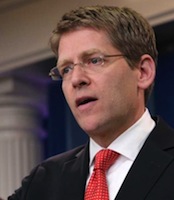 that
limits the legal definition of marriage to a union between a man and
a woman, the White House said Tuesday, taking
another step in support of gay rights that
limits the legal definition of marriage to a union between a man and
a woman, the White House said Tuesday, taking
another step in support of gay rights
Jay Carney (right),
the White House press secretary, said Mr. Obama was taking
the additional step away from the Defense of Marriage Act
— which the administration said earlier this year it would no
longer defend in court — in order
to “uphold the principle that the federal
government should not deny gay and lesbian couples the same rights
and legal protections as straight couples.”
If the measure passes, it would make same-sex couples eligible for
certain federal benefits that have previously been available only
to heterosexual married couples.
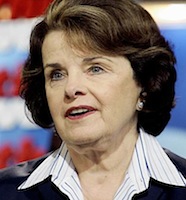
The new legislation, which is being
sponsored by Senator Dianne Feinstein,
Democrat of California, is unlikely to pass Congress
this year, but will nonetheless face its first committee hearing on
Wednesday before the Senate Judiciary
Committee.
“More and more people across this land know people who are gay,
who want to have a lasting relationship, who look at marriage as an
economic agreement as well as an emotional agreement,” Mrs.
Feinstein said in remarks at the National Press Club. “I think
eyes have opened.”
 The
Obama administration said in February that it would no longer defend
the Defense of Marriage Act in legal proceedings, and Attorney
General Eric H. Holder Jr. said for the first time that Mr.
Obama believed the act was unconstitutional. The
Obama administration said in February that it would no longer defend
the Defense of Marriage Act in legal proceedings, and Attorney
General Eric H. Holder Jr. said for the first time that Mr.
Obama believed the act was unconstitutional.
The president has said in the past that
he opposes same-sex marriage on religious grounds; as a Christian,
he has said, he views marriage as a union of a man and a woman. But
the White House has said more recently that the president’s
views on the issue are “evolving.”
Mr. Obama ran for office promising to
be a fierce advocate for the rights of gay men and lesbians, and proponents
of gay rights say that in many respects he has delivered.
He signed a new hate crimes law, pushed Congress to allow gay men,
lesbians and bisexuals to serve openly in the military and withdrew
legal support for the Defense of Marriage Act.
(Full
text)
|

GOV.
ANDREW M. CUOMO signs
the marriage bill
|
A
triumph for Equal Rights, a victory for
SECULARISM!
New
York Allows Same-Sex Marriage, Becoming Largest State to Pass Law
By NICHOLAS CONFESSORE and MICHAEL BARBARO
The New York Times: June 24, 2011
ALBANY
— Lawmakers voted late Friday
to legalize same-sex marriage, making New York the largest state where
gay and lesbian couples will be able to wed and giving the national
gay-rights movement new momentum from the state where it was born.
The marriage bill, whose fate was uncertain until moments before the
vote, was approved 33 to 29 in a packed but hushed Senate chamber.
Four members of the Republican majority
joined all but one Democrat in the Senate in supporting the measure
after an intense and emotional campaign aimed at the handful of lawmakers
wrestling with a decision that divided their friends, their constituents
and sometimes their own homes.
With his position still undeclared, Senator
Mark J. Grisanti, a  Republican
from Buffalo who had sought office promising to oppose same-sex marriage,
told his colleagues he had agonized for months
before concluding he had been wrong. Republican
from Buffalo who had sought office promising to oppose same-sex marriage,
told his colleagues he had agonized for months
before concluding he had been wrong.
“I apologize for those who feel offended,”
Mr. Grisanti said, adding, “I cannot
deny a person, a human being, a taxpayer, a worker, the people of
my district and across this state, the State of New York, and those
people who make this the great state that it is the same rights that
I have with my wife.”
Senate approval was the final hurdle for the same-sex marriage legislation,
which was approved last week by the Assembly.
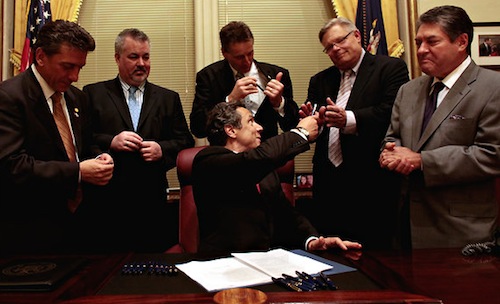
Gov. Andrew M.
Cuomo signed the measure at 11:55 p.m., and the law will go
into effect in 30 days, meaning that same-sex couples
could begin marrying in New York by late July.
Passage of same-sex marriage here followed a daunting run of defeats
in other states where voters barred same-sex marriage by legislative
action, constitutional amendment or referendum. Just
five states currently permit same-sex marriage: Connecticut, Iowa,
Massachusetts, New Hampshire and Vermont, as well as the District
of Columbia.
At around 10:30 p.m., moments after the vote was announced, Mr.
Cuomo strode onto the Senate floor to wave at cheering supporters
who had crowded into the galleries to watch. Trailed
by two of his daughters, the governor greeted lawmakers, and
paused to single out those Republicans who had defied the majority
of their party to  support
the marriage bill. support
the marriage bill.
“How do you feel?” he asked Senator
James S. Alesi, a suburban Rochester Republican who voted against
the measure in 2009 and was the first to break party ranks this year.
“Feels good, doesn’t it?”
The approval of same-sex marriage represented a reversal of fortune
for gay-rights advocates, who just two years ago suffered a humiliating
defeat when a same-sex marriage bill was easily rejected by the Senate,
which was then controlled by Democrats. This
year, with the Senate controlled by Republicans, the odds against
passage of same-sex marriage appeared long. But the unexpected victory
had a clear champion: Mr. Cuomo.
Mr. Cuomo made same-sex marriage one
of his top priorities for the year and deployed his top aide to coordinate
the efforts of a half-dozen local gay-rights organizations whose feuding
and disorganization had in part been blamed for the defeat two years
ago.
The new coalition of same-sex marriage supporters brought in one of
Mr. Cuomo’s trusted campaign operatives to supervise a $3 million
television and radio campaign aimed at persuading several Republican
and Democratic senators to drop their opposition.
For Senate Republicans, even bringing
the measure to the floor was a freighted decision.
Most of the Republicans firmly oppose same-sex marriage on moral grounds,
and many of them also had political concerns, fearing that allowing
same-sex marriage to pass on their watch would embitter conservative
voters and cost the Republicans their one-seat majority in the Senate.

But after days of contentious discussion
capped by a marathon nine-hour closed-door debate on Friday, Republicans
came to a fateful decision: The full Senate would be allowed to vote
on the bill, the majority leader, Dean G. Skelos,
said Friday afternoon, and each member would be left to vote according
to his or her conscience.
Republican lawmakers spent much of the
week negotiating changes to the marriage bill to
protect religious institutions, especially
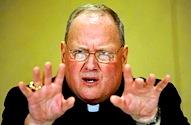 those
that oppose same-sex weddings. On Friday, the
Assembly and the Senate approved those changes. But
they were not enough to satisfy the measure’s staunchest opponents.
In a joint statement, New York’s Catholic bishops assailed the
vote. those
that oppose same-sex weddings. On Friday, the
Assembly and the Senate approved those changes. But
they were not enough to satisfy the measure’s staunchest opponents.
In a joint statement, New York’s Catholic bishops assailed the
vote.
“The passage by the Legislature of a bill
to alter radically and forever humanity’s historic understanding
of marriage leaves us deeply disappointed and troubled,”
the bishops said.
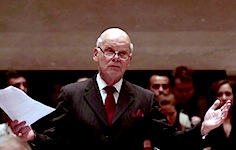 
Besides Mr. Alesi and Mr. Grisanti,
the four Republicans who voted for the measure included Senators
Stephen M. Saland (left) from the Hudson Valley area and Roy
J. McDonald (right) of the capital region.
Just
one lawmaker rose to speak against the bill: Rubén
Díaz Sr. of 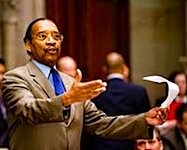 the
Bronx, the only Democratic senator to cast a no vote.
Mr. Díaz, saying
he was offended by the two-minute restrictions set on speeches, repeatedly
interrupted the presiding officer who tried to limit the senator’s
remarks, shouting, “You don’t want
to hear me.” the
Bronx, the only Democratic senator to cast a no vote.
Mr. Díaz, saying
he was offended by the two-minute restrictions set on speeches, repeatedly
interrupted the presiding officer who tried to limit the senator’s
remarks, shouting, “You don’t want
to hear me.”
“God, not Albany, has settled the definition of marriage, a
long time ago,” Mr. Díaz said.
In New York, passage of the bill reflects rapidly evolving sentiment
about same-sex unions. In 2004, according
to a Quinnipiac poll, 37 percent of the state’s residents supported
allowing same-sex couples to wed. This year,
58 percent of them did.
Dozens more states have laws or constitutional amendments banning
same-sex marriage. But New York could be a shift: It is now by far
the largest state to grant legal recognition to same-sex weddings,
and one that is home to a large, visible and politically influential
gay community.
Supporters of the measure described
the victory in New York as especially symbolic — and poignant
— because of its rich place in the history of gay rights: the
movement’s foundational moment, in June
1969, was a riot against police at the Stonewall
Inn, a bar in the West Village. On Friday night,
as the Senate voted a crowd jammed into the Stonewall Inn, where televisions
were tuned to the Senate hours before the vote began.
On
the streets where police beat gay men in 1969, on Friday crowds cheered
ar police quiely stood watch.
|

GAY
PRIDE MARCH
Sunday, 26 June 2011
|
Cheering
a Gay Marriage
Law, and
Its Champions
By JOHN LELAND
The New York Times: June 27, 2011

Mayor
Michael Bloomberg, City
Council Speaker Christine Quinn,
Gov. Andrew Cuomo
Two
days after New York became the sixth and largest state to legalize
same-sex marriage, participants in the 42nd
annual gay pride parade on Sunday used the
occasion to reflect somberly on the  gains
and losses of the past year. gains
and losses of the past year.
Kidding!
They came to shout, dance, cheer, strut, hug and shed tears of joy,
knowing that on July 24, when the law takes effect, the season for
tears will begin in earnest.
The focus of much of the cheering was
Gov. Andrew M. Cuomo, a Democrat, who
made legalization of same-sex marriage part of his election campaign
and visibly led the fight for its approval in the Republican-led State
Senate.
Mr. Cuomo marched with several local
politicians, including Mayor  Michael
R. Bloomberg and the New York City Council
speaker, Christine C. Quinn, who is gay. But
there was little question that the governor was the parade’s
rock star, eliciting shrieks as he made his way down Fifth Avenue. Michael
R. Bloomberg and the New York City Council
speaker, Christine C. Quinn, who is gay. But
there was little question that the governor was the parade’s
rock star, eliciting shrieks as he made his way down Fifth Avenue.
The roar became almost deafening as the parade turned onto Christopher
Street in the West Village. People leaned over police
barriers to get a glimpse of the governor or to catch the attention
of the cameras following him.
“Finally we got someone who does what
he believes in,” said Chuck Sawyer, 49,
a fund-raiser for the American Lung Association, who added that he
and his partner would probably get married in late  summer.
“He’s been doing what he
said he’d do. A lot of past governors and even the president
haven’t come through. He did.” summer.
“He’s been doing what he
said he’d do. A lot of past governors and even the president
haven’t come through. He did.”
Revelers held up thousands of printed
signs reading “Promise Kept!”
and “Thank You Gov. Cuomo,”
and Mayor Bloomberg waved a rainbow flag. The signs were from New
Yorkers United for Marriage, a coalition of previously
squabbling organizations that Mr. Cuomo helped forge.
But it was Mr. Cuomo who basked in the crowd’s attention, beaming
and pointing at individuals along the route.
“I’ve been to the parade
many times, and there’s always a lot of  energy
and it’s always been a ball, but this was special,” the
governor said as he stepped out of the parade on Christopher Street.
“I think you’re going to see this
message resonate all across the country now. If New York can do it,
it’s O.K. for every other place to do it.” energy
and it’s always been a ball, but this was special,” the
governor said as he stepped out of the parade on Christopher Street.
“I think you’re going to see this
message resonate all across the country now. If New York can do it,
it’s O.K. for every other place to do it.”
After a legislative session in which Mr. Cuomo drove through several
measures opposed by liberals, including a cap on property tax increases,
the governor said, “New York is the progressive
capital of the nation. And it’s that once again, and it’s
a pleasure to be part of it today.”
 In
a rare public appearance with the governor, Mr.
Cuomo’s In
a rare public appearance with the governor, Mr.
Cuomo’s  girlfriend,
Sandra Lee (left with Gov. Cuomo),
a celebrity chef who has a gay brother, marched by his side. Ms.
Lee figured into Mr. Cuomo’s deliberations over same-sex marriage,
according to those who know the couple: she repeatedly reminded him
that she wanted the law girlfriend,
Sandra Lee (left with Gov. Cuomo),
a celebrity chef who has a gay brother, marched by his side. Ms.
Lee figured into Mr. Cuomo’s deliberations over same-sex marriage,
according to those who know the couple: she repeatedly reminded him
that she wanted the law  changed. changed.
Other officials in the
parade included State Senator Thomas
K. Duane (left
with partner LouisWebre) and
Assemblyman Daniel J. O’Donnell, both
Manhattan Democrats; the state attorney
general, Eric T. Schneiderman; and Congresswoman
Nydia M. Velázquez, whose district includes
parts of Manhattan, Brooklyn and Queens.
Several
people carried hand-lettered signs thanking by name
the
four
Republican senators who   voted
for the bill [Senators
James S. Alesi, Mark
J. Grisanti, Stephen
M. Saland and Roy J. McDonald]. voted
for the bill [Senators
James S. Alesi, Mark
J. Grisanti, Stephen
M. Saland and Roy J. McDonald].
Former Gov. David
A. Paterson, who unsuccessfully pushed for a same-sex-marriage
bill in a Democrat-led Senate in 2009, marched a few blocks behind
Mr. Cuomo. He held a blue sign that read,
“Thank you Gov. Cuomo.”
|

\
|
Gay
Marriage: A Milestone
EDITORIAL
The New York Times: June 26, 2011
 New York State has made a powerful and
principled choice by giving all
New York State has made a powerful and
principled choice by giving all  couples
the right to wed and enjoy the legal rights of marriage. It
is a proud moment for New Yorkers, thousands
of whom took to the streets on Sunday to celebrate this step forward.
But this moment does not erase the
bigotry against gays and lesbians enshrined in the federal Defense
of Marriage Act, which denies federal recognition of same-sex
marriages and allows any state to refuse to recognize another state’s
unions. couples
the right to wed and enjoy the legal rights of marriage. It
is a proud moment for New Yorkers, thousands
of whom took to the streets on Sunday to celebrate this step forward.
But this moment does not erase the
bigotry against gays and lesbians enshrined in the federal Defense
of Marriage Act, which denies federal recognition of same-sex
marriages and allows any state to refuse to recognize another state’s
unions.
Though there was unnecessary secrecy in the negotiations,
Gov. Andrew Cuomo made a determined effort to achieve
marriage equality in New York. He shares
credit with the four Republican state senators who bucked their party
and threats from conservatives to do what they knew was right. State
Senators James Alesi, Roy McDonald, Mark Grisanti and Stephen Saland,
all from upstate districts, deserve the support of their communities.
They showed the kind of strength that is extremely hard to find in
today’s politics.
In drafting a compromise, however, Senator Saland and other Republicans
insisted on language that carves out exceptions for religious institutions
and not-for-profit corporations affiliated with those religious entities.
That provision allows those tax-exempt entities to refuse to marry
a same-sex couple or to allow the use of their buildings or services
for weddings or wedding parties. There was simply no need for these
exemptions, since churches are protected under both the federal Constitution
and New York law from being required to marry anyone against their
beliefs. Equally troubling, an “inseverability clause”
in the act appears to make it impossible for any court to invalidate
part of the law without invalidating the whole law — raising
questions about what happens to  couples
during an appeal. couples
during an appeal.
This legislative session will be remembered for New York’s acceptance
of same-sex marriage, a milestone in the national fight for this fundamental
freedom. Five other states, along with the District of Columbia, allow
same-sex couples to marry. But more than three dozen states define
marriage as between a man and a woman.
For
gays and lesbians, the battle for freedom from discrimination continues.
|
|
Cuomo
approval at 64 percent among NY voters: poll
ASSOCIATED PRESS: June 29, 2011
ALBANY, N.Y. — A new poll shows
Democratic Gov. Andrew Cuomo with high approval ratings
among New York voters, including members of the Republican
 Party
and Catholics whose church leaders opposed his successful
push last week to legalize gay marriage. Party
and Catholics whose church leaders opposed his successful
push last week to legalize gay marriage.
The Quinnipiac University poll
shows the overall approval rating for
the way Cuomo is handling the job at 64 percent,
far higher than ratings for any of six other governors in its recent
surveys, including New Jersey Gov. Chris Christie.Cuomo’s approval
ratings, matching an April peak overall, are 53
percent among Republicans, 63 percent
among union households and 62 percent among
Catholics.
Quinnipiac surveyed 1,317 registered voters from last Monday through
Sunday, two days after gay marriage was legalized. The poll has a
margin of error of 2.7 percentage points.
(Full
article)
|
|
Texas:
Lawsuit Over Prayer Day
By THE ASSOCIATED PRESS
Associated Press: July 14, 2011
A group of atheists and agnostics filed
a federal lawsuit on  Wednesday
in Houston seeking to stop an evangelical
Christian prayer event next month that is endorsed by Gov.
Rick Perry. In its lawsuit, the Freedom
from Religion Foundation
argues that Mr. Perry’s day of prayer and fasting would violate
the constitutional ban on government endorsement of a religion.
The event, which is called the Response
and is billed as Christian-only, is scheduled for Aug. 6 at Reliant
Stadium in Houston. The group, which unsuccessfully
sued to stop a national day of prayer earlier this year, filed the
case on behalf of 700 members in Texas and called on the court to
stop Mr. Perry, a Republican who is contemplating a presidential run,
from participating in the meeting or using his office to promote or
recognize it. A spokeswoman for Mr.
Perry said the lawsuit would not change his plans. Wednesday
in Houston seeking to stop an evangelical
Christian prayer event next month that is endorsed by Gov.
Rick Perry. In its lawsuit, the Freedom
from Religion Foundation
argues that Mr. Perry’s day of prayer and fasting would violate
the constitutional ban on government endorsement of a religion.
The event, which is called the Response
and is billed as Christian-only, is scheduled for Aug. 6 at Reliant
Stadium in Houston. The group, which unsuccessfully
sued to stop a national day of prayer earlier this year, filed the
case on behalf of 700 members in Texas and called on the court to
stop Mr. Perry, a Republican who is contemplating a presidential run,
from participating in the meeting or using his office to promote or
recognize it. A spokeswoman for Mr.
Perry said the lawsuit would not change his plans.
(Full
text)
|

MATTHEW
HESS
San Diego activist


MARC
STERN
American Jewish Committee

JENA
TROUTMAN
|
Efforts
to Ban Circumcision Gain Traction in California
By JENNIFER MEDINA
The New York Times: June 4, 2011
SANTA MONICA,
Calif. — When a group of activists
proposed banning  circumcision
in San Francisco last
fall, many people simply brushed them aside. Even in that liberal
seaside city, it seemed implausible
that thousands of people would support an effort to outlaw an ancient
ritual that Jews and Muslims believe fulfills a commandment issued
by God. circumcision
in San Francisco last
fall, many people simply brushed them aside. Even in that liberal
seaside city, it seemed implausible
that thousands of people would support an effort to outlaw an ancient
ritual that Jews and Muslims believe fulfills a commandment issued
by God.
But last month, the group collected
the more than 7,100 signatures needed to get a measure on the fall
ballot that would make it illegal to snip the foreskin of a minor
within city limits. Now a similar effort is under
way in Santa Monica to get such a measure on the ballot for  November
2012. November
2012.
If the anticircumcision activists (they
prefer the term “intactivists”)
have their way, cities across the country may be voting on whether
to criminalize a practice that is common in many American hospitals.
Activists say the measures would protect
children from an unnecessary medical procedure, calling it “male
genital mutilation.”
“This is the furthest we’ve
gotten, and it is a huge step for us,” said
Matthew Hess, an activist based in San Diego who wrote both
bills.
Mr. Hess has created similar legislation for states across the country,
but those measures never had much traction. Now he is fielding calls
from people who want to organize similar movements in their cities.
“This is a conversation we are
long overdue to have in this country,” he said. “The
end goal for us is making cutting boys’ foreskin a federal crime.”

Jewish groups see the ballot measures
as a very real threat, likening them to bans on circumcision
that existed in Soviet-era Russia and Eastern Europe and in ancient
Roman and Greek times. The circumcision
of males is an inviolable requirement of Jewish law that dates back
to Abraham’s circumcision of himself
in the Book of Genesis.
They say the proposed ban is an assault on religious freedom that
could have a widespread impact all over the country. Beyond the biblical,
there are emotional connections: checking for circumcision was one
of the ways Jewish children could be culled from their peers by Nazis
and the czar’s armies.
“People are shocked that it has
reached this level because there has never been this kind of a direct
assault on a Jewish practice here,” said Marc
Stern, associate general counsel for the American Jewish Committee,
an advocacy group. “This is something that American Jews have
always taken for granted — that something that was so contested
 elsewhere
but here, we’re safe and we’re secure.” elsewhere
but here, we’re safe and we’re secure.”
Mr. Hess also writes an online comic
book, “Foreskin Man,” with
villains like “Monster Mohel (a rabbi specializing in circumcisions).”
On Friday, the Anti-Defamation
League issued a statement saying the comic employed “grotesque
anti-Semitic imagery."
Jena Troutman (right),
the mother of two young  boys
who is promoting the ballot measure
in Santa Monica, said she views her work as a chance
to educate would-be parents against
a procedure that “can really do serious damage to the child.” boys
who is promoting the ballot measure
in Santa Monica, said she views her work as a chance
to educate would-be parents against
a procedure that “can really do serious damage to the child.”
Ms. Troutman has run the Web site wholebabyrevolution.com
for two years, and she is fond of rattling off sayings like “Your
baby is perfect, no snipping required.” Well
versed in the stories of circumcisions gone awry, she said the
recent death of a New York City toddler who was circumcised at a hospital
convinced her that she should push for the ballot measure.
If the ballot measure passed, it would certainly face legal challenges.
But several legal experts said it was far from certain that it would
be struck down in a court.
Ms. Troutman said she considered putting religious exemptions
in the measure, but then decided, “Why
should only some babies be protected?”
FOLLOWUP
DEFERRING TO THE RELIGIOUS RIGHT

In
Santa Monica, Circumcision Opponent Abandons Efforts
By JENNIFER MEDINA
The New York Times: June 7, 2011
LOS ANGELES — The
primary backer of an effort to get a ban on circumcision on the ballot
in Santa Monica is abandoning her push, saying the proposed legislation
had been misrepresented as an effort to impinge on religious freedom.
A similar measure in San Francisco is scheduled for
a fall vote.
The woman, Jena
Troutman, a mother of two boys who began the
process of trying to get a ban on the Santa Monica municipal ballot
in 2012, said the news media had distorted the effort.
“The religious opposition really rose up,
and I never intended it to be about that at all,” Ms. Troutman
said. “Ninety-five percent of babies who are circumcised have
nothing to do with religion — that’s
what I was focused on. Once I discovered
this bill was not going to open up the conversation but was closing
it down, I wanted no part of it.”
Ms. Troutman said she wanted to focus
on educating parents through the Web site she runs,
wholebabyrevolution.com.
In recent days, criticism of the two
measures had focused on their author, Matthew
Hess, who lives in San Diego and
created an online comic called
“Foreskin Man,” which features characters
like “Monster Mohel.”
Several organizations, including   the
Anti-Defamation League, said
the comic relied on anti-Semitic imagery. the
Anti-Defamation League, said
the comic relied on anti-Semitic imagery.
Mr. Hess defended the comic, saying
it was intended to be from a baby’s point of view.
“It was designed to really evoke a response that talking about
studies and statistics never does,” Mr. Hess said. “What
would that baby be thinking other than ‘That
man coming at me with a knife is a monster’?”
Mr. Hess said Tuesday that he was optimistic about the prospect of
the ban passing in San Francisco.
|
|
Court
Lets City Restrict Church Use of Schools
By BENJAMIN WEISER
The New York Times: June 2, 2011
New York City may again block religious
groups from using school facilities outside of regular school hours
for “religious worship services,” a federal
appeals court in Manhattan ruled on Thursday.
Deciding 2 to 1, a panel of the United
States Court of Appeals for the Second Circuit said the city had “a
strong basis to believe” that allowing the religious services
to be conducted in schools could be seen as the kind of endorsement
of religion that violated  the
First Amendment’s establishment clause. the
First Amendment’s establishment clause.
“When worship services are performed in a place,” Judge
Pierre N. Leval wrote for the majority, “the
nature of the site changes. The site is no longer simply a room in a
school being used temporarily for some activity.”
“The place has, at least for a time,
become the church,” he wrote, adding that the
city’s policy imposed “no restraint on the free expression
of any point of view.” Rather, it
applied only to “a certain type of activity — the conduct
of worship services — and not to the free expression of religious
views associated with it.”
The decision is the latest twist in a legal battle that dates
to 1995, when an evangelical Christian church,
the Bronx Household of Faith, sued,
contending the city was violating the First Amendment in denying it
access to a school, when it allowed other community groups to have space
for their activities. |

ROGER VANGHELUWE
|
Belgian
Church Will Pay Victims of Sexual Abuse
By STEPHEN CASTLE
The New York Times: May 30, 2011
After a tumultuous year following the
resignation of Roger Vangheluwe,
a Roman Catholic bishop
who admitted sexually abusing children, the
church in Belgium bowed to pressure on Monday and agreed in principle
to compensate some of the hundreds who claim that they were also victims
of clerics.
The church had previously promised to engage with those who suffered
abuse but had not recognized the need to pay financial compensation,
 despite
the harrowing testimony of many of the accusers. A report by a commission
set up by the church said last year that 13 people were believed to
have committed suicide as a result of sexual abuse by clerics. despite
the harrowing testimony of many of the accusers. A report by a commission
set up by the church said last year that 13 people were believed to
have committed suicide as a result of sexual abuse by clerics.
In a statement, the Belgian bishops and religious superiors said they
now wanted to “help victims restore
their dignity and, according to their needs, provide financial help.”
The bishops were responding to a report from a parliamentary commission
in March that called for the creation of panel to adjudicate compensation
claims for those who say they were abused by clergy.
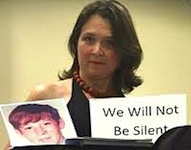 Lieve
Halsberghe, who represents the Survivors Network of Those Abused
by Priests, criticized the fact that the church was
expected to be represented on the adjudication panel. “They
can’t be the accused and the judge at the same time,”
she said. Lieve
Halsberghe, who represents the Survivors Network of Those Abused
by Priests, criticized the fact that the church was
expected to be represented on the adjudication panel. “They
can’t be the accused and the judge at the same time,”
she said.
“It’s good that they are willing to pay,”
Ms. Halsberghe said, “but far more
important than money is the truth, and so far we haven’t had the
truth in Belgium. I will never believe a bishop until I see what he
is doing, because the words are meaningless.” |

FAITH HEALING
|
Changes
in Oregon Law Put Faith-Healing Parents on Trial
By ISOLDE RAFTERY
The New York Times: May 29, 2011
OREGON CITY, Ore. — At the Clackamas
County courthouse here, Timothy
 and
Rebecca Wyland sat next to each other — ramrod
straight, their shoulders barely touching — as they watched
images of their daughter flash on the screen. and
Rebecca Wyland sat next to each other — ramrod
straight, their shoulders barely touching — as they watched
images of their daughter flash on the screen.
At birth, the girl, Alayna, was a pink-cheeked bundle, but by 6 months,
a growth the size of a baseball had consumed the left side of her
face, pushing her eyeball out of its socket. The
Wylands, members of the Followers of Christ Church, a faith-healing
sect whose members shun medicine, would not take her
to a doctor.
“Timothy and Rebecca Wyland —
they recognized that medical attention was mandated for this condition,”
said Christine Landers, the state prosecutor
who is trying the Wylands for first-degree
criminal mistreatment, a felony that can carry a five-year
prison term.
“Instead,
they anointed her with oils and laid down hands.”
 Alayna
was found to have a hemangioma, a benign tumor that may cause blindness
if it grows around the eye. Alayna
was found to have a hemangioma, a benign tumor that may cause blindness
if it grows around the eye.
In June, half a dozen police officers and a caseworker took the infant
from her parents and placed her in foster care for two months while
she received treatment. She is now 17 months old.
Mr. Wyland, 45, and Ms. Wyland, 24,
are the most recent members of the Followers of Christ Church to face
trial for not obtaining medical care for their children.
 The
church first came under criticism in 1998 after the local news media
reported that of the 78 children buried
in the church’s graveyard ['baby row'], at least 21 could have
survived if they had received medical attention. The
church first came under criticism in 1998 after the local news media
reported that of the 78 children buried
in the church’s graveyard ['baby row'], at least 21 could have
survived if they had received medical attention.
At the time, Clackamas
County prosecutors said they were prevented from intervening
by Oregon laws that gave legal protection to parents who refused because
of their faith to seek medical care for their children.
The next year, the state Legislature
repealed this exemption.
|
|
Married
Couples Are No Longer a Majority, Census Finds
By SABRINA TAVERNISE
The New York Times: May 26, 2011
WASHINGTON — Married couples have
dropped below half of all American households for the
first time, the Census Bureau says, a milestone  in
the evolution of the American family toward less traditional forms. in
the evolution of the American family toward less traditional forms.
Married couples represented just 48 percent of American households in
2010, according to data being made public Thursday and analyzed by the
Brookings Institution. This was slightly less than in 2000, but far
below the 78 percent of households occupied by married couples in 1950.
What is more, just a fifth of households
were traditional families — married couples with children —
down from about a quarter a decade ago, and from 43 percent in 1950,
as the iconic image of the American family continues
to break apart.

In recent history, the marriage rate among
Americans was at its highest in the 1950s, when the
institution defined gender roles, family life and a person’s place
in society. But as women moved into the work force, cohabitation lost
its taboo label, and as
society grew more secular, marriage lost some of its central
authority. |
| 
GUILT
|
Athiests
have more fulfilling sex than believers
By JEREMY OLSHAN
The New York P:ost: May 21, 2011
God is BAD in bed!
  Although
the Lord is frequently invoked during sex, belief
in religion puts a damper on one's sex life, according to a
new study. Although
the Lord is frequently invoked during sex, belief
in religion puts a damper on one's sex life, according to a
new study.
Atheists have more fulfilling sex than
believers, because they are freer from the guilty feelings imposed
by religions, according to the survey of  14,000
people conducted by psychologist Darrel
Ray (below
left)and Kansas University researcher Amanda
Brown. 14,000
people conducted by psychologist Darrel
Ray (below
left)and Kansas University researcher Amanda
Brown.

"The amount of masturbation, or
sex, or kinky behavior is no different between the religious groups,
but the feelings of guilt vary considerably,"
said Ray, an outspoken
atheist.
Mormons ranked highest
on the scale of sexual guilt, with an average score of 8.19
out of 10, according to the survey, followed
closely by Jehovah's   Witnesses,
Pentecostal Christians, Seventh Day Adventists and Baptists. Witnesses,
Pentecostal Christians, Seventh Day Adventists and Baptists.
The Catholics surveyed reported an average
guilt rating of 6.34. By contrast, atheists
rated their shame levels at 4.71, and agnostics 4.81.
"One of the biggest surprises of
the study was that we found that   once
people leave religion, their enjoyment of sex seems to greatly increase,"
Ray said. "That's what they told us, anyway." once
people leave religion, their enjoyment of sex seems to greatly increase,"
Ray said. "That's what they told us, anyway."
These former believers scored their
post-religion enjoyment of sex a
7.8 out of 10 average.
Guilt was particularly high on the subjects of masturbation and pre-marital
sex, the study found.
 "Those
raised with religion reported feeling "Those
raised with religion reported feeling  incredibly
guilty about
masturbation -- the guilt
scores were just off the charts,”
Ray said. “One respondent told
me, ‘If I masturbated under the covers,
I thought God couldn’t see me,'
but afterwards I still prayed for forgiveness.” incredibly
guilty about
masturbation -- the guilt
scores were just off the charts,”
Ray said. “One respondent told
me, ‘If I masturbated under the covers,
I thought God couldn’t see me,'
but afterwards I still prayed for forgiveness.”
Despite
the imposition of guilt, religion does not appear to have  much
impact on the amount of masturbation and premarital sex, however. much
impact on the amount of masturbation and premarital sex, however.
“The moral of the story uis that
sex happens,” Ray said. “Those
hormones are raging no matter what the religion.”
So while the sex itself may not vary between believers and nonbelievers,
the post-coital experience tends to be more positive for atheists,
he said.
(Full
story - Print version)
|
| 
NICHOLAS
D. KRISTOF
|
Religion
and Sex Quiz
By NICHOLAS D. KRISTOF
May 21, 2011

Faith is a huge force in American life, and it’s common to hear
the Bible cited to bolster political and moral positions, especially
against same-sex marriage and abortion. So
here’s my 2011 religion quiz. Choose the best
responses (some questions may have more than
one correct answer):
1.
The Bible’s position on abortion is:
a. Never mentioned.
b. To forbid it along with all forms of artificial birth control.
c. Condemnatory, except to save the life of the mother.

2. The Bible suggests “marriage”
is:
a. The lifelong union of one man and one woman.
b. The union of one man and up to 700 wives.
c. Often undesirable, because it distracts from service to the Lord.
3. The Bible says of homosexuality:

a. Leviticus describes male sexual pairing as an abomination.
b. A lesbian should be stoned at her father’s
doorstep.
c. There’s plenty of ambiguity and no indication of physical
intimacy, but some readers point to Ruth and
Naomi’s love as suspiciously close, or to King
David declaring to Jonathan: “Your love
to me was wonderful, passing the love of women.”
(II Samuel 1:23-26)
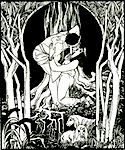 4.
In the Bible, erotic writing is: 4.
In the Bible, erotic writing is:
a. Forbidden by Deuteronomy as “adultery of the heart.”
b. Exemplified by “Song of Songs,”
which celebrates sex for its own sake.
c. Unmentioned.
5. Jesus says that divorce is permitted:
a. Only after counseling and trial separation.
b. Never.
c. Only to men whose wives have been unfaithful.

6. Among sexual behavior that is forbidden is:
a. Adultery.
b. Incest.
c. Sex with angels.

7. The people of Sodom were condemned principally for:
a. Homosexuality.
b. Blasphemy.
c. Lack of compassion for the poor and needy.
This
quiz, and the answers below, draw from a new book, “Unprotected
Texts: The Bible’s Surprising Contradictions about Sex and Desire.”
It’s by Jennifer Wright Knust,
a Bible scholar at Boston University who is also an ordained American
Baptist pastor.
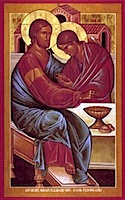 Professor
Knust’s point is that the Bible’s teachings about sexuality
are murky and inconsistent and prone to being hijacked by ideologues
(this quiz involves some cherry-picking of my own). Professor
Knust’s point is that the Bible’s teachings about sexuality
are murky and inconsistent and prone to being hijacked by ideologues
(this quiz involves some cherry-picking of my own).
There’s also lots we just don’t understand:
What exactly is the offense of “arsenokoitai”
or “man beds”
that St. Paul proscribes? It is often
translated as a reference to homosexuality, but it more plausibly
relates to male prostitution or pimping. Ambiguity
is everywhere, which is why some of you will surely harrumph at my
quiz answers.
For
answers click √
on Kristof image
|
| 
MIKE GILLIS
|
Harold
Camping mum about judgment day, atheists aren't
By AMY ROLPH
SEATTLEPI.COM: Saturday, May 21, 2011, 09:16 p.m.
SEATTLE -- The world didn't end Saturday
at 6 p.m.
Despite the predictions of a radio broadcaster turned prophet, 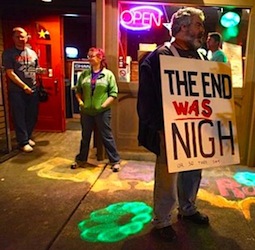 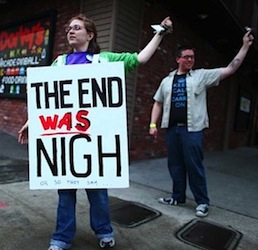 massive
earthquakes didn’t rock the entire Earth. The righteous didn’t
rise up to heaven as 6 p.m. struck in timezones all over the world,
and trumpets
didn’t sound to mark the start of Armageddon. massive
earthquakes didn’t rock the entire Earth. The righteous didn’t
rise up to heaven as 6 p.m. struck in timezones all over the world,
and trumpets
didn’t sound to mark the start of Armageddon.

For atheists, this could be an "I
told you so" moment. But that would be too easy. Almost too easy,
anyway.
Instead of gloating,
some atheists hoisted beers and called the latest failed prediction
of Family Radio's Harold Camping a lesson
in human behavior.
“We
know he’s not the first or the last who’s going to do
this,” said Mike Gillis, a host and producer
of the Seattle-area radio show Ask
An Atheist on KLAY
1180 AM.
Gillis is one of a handful of atheists who planned a “rapture
party” Saturday night at Dorky's Arcade in Tacoma, about 30
miles south of Seattle. About 80 people RSVPed to the event on Facebook,
saying they’d come listen to music and wait for confirmation
that there wasn’t any rapture.
"I'm down," one Facebook fan joked on the event listing.
"But just until the looting starts."
The producers at Ask An Atheist have had their eye on Camping and
his doomsday prophecies for a while. They started an online “countdown
to backpedaling” clock about six months ago,
ticking off the seconds until the religious leader would offer an
explanation about why judgment day stood him up.
So far, Camping hasn't explained what
happened.

|
 THE
CIRCFUMCISION OF CHRIST
THE
CIRCFUMCISION OF CHRIST
Artist unknown |
California:
Circumcision on Ballot
By THE ASSOCIATED PRESS
The New Yprk Times: May 18, 2011
A group seeking to ban the circumcision of male
children in San Francisco has succeeded in getting the measure on the
November ballot. City elections
  officials
confirmed Wednesday that the initiative had received enough signatures
to appear on the ballot, getting more than 7,700 valid signatures from
city residents. Initiatives must receive at least 7,168 signatures to
qualify. If the measure passes, circumcision would be prohibited among
males under the age of 18. The practice would become a misdemeanor offense
punishable by a fine of up to $1,000 or up to one year in jail. There
would be no religious exemptions. The initiative appears to be the first
of its kind in the country to actually make it to this stage, though
a larger national debate over the health benefits of circumcision has
been going on for many years. officials
confirmed Wednesday that the initiative had received enough signatures
to appear on the ballot, getting more than 7,700 valid signatures from
city residents. Initiatives must receive at least 7,168 signatures to
qualify. If the measure passes, circumcision would be prohibited among
males under the age of 18. The practice would become a misdemeanor offense
punishable by a fine of up to $1,000 or up to one year in jail. There
would be no religious exemptions. The initiative appears to be the first
of its kind in the country to actually make it to this stage, though
a larger national debate over the health benefits of circumcision has
been going on for many years.
(Full
article)
Above
left: THE BRICK TESTAMENT
Genesis 21:4-5
Abraham circumcised his son Isaac when he was eight days old.
Abraham was a hundred years old when his son Isaac was born to him.
|
| 

PHIL
ZUCKERMAN
Socioplogist of Religion
|
Pitzer
College in California Adds Major in Secularism
By LAURIE GOODSTEIN
The New York Times: May 8, 2011
Colleges
and universities have long offered majors in religion or theology.
 But
with more and more people now saying they have no religion, one college
has decided to be the first to offer a major in secularism. Starting
this fall, Pitzer College, a small liberal
arts institution in Southern California, will inaugurate a department
of secular studies. But
with more and more people now saying they have no religion, one college
has decided to be the first to offer a major in secularism. Starting
this fall, Pitzer College, a small liberal
arts institution in Southern California, will inaugurate a department
of secular studies.
The department was proposed by Phil
Zuckerman, a sociologist
of religion, who describes
himself as “culturally Jewish, but agnostic-atheist on questions
of deep mystery.” Over the years he grew increasingly
intrigued by the growth of secularism in the United States and around
the world. He studied and taught in Denmark, one of the world’s
most secular countries, and has written several books about atheism.
Studying nonbelief is as valid as studying
belief, Mr. Zuckerman said, and the new major will make that very
clear.
“There are hundreds of millions
of people who are nonreligious. I want to know who they are, what
they believe, why they are nonreligious. You have some countries where
huge percentages of people — Czechs, Scandinavians — now
call themselves atheists. Canada is experiencing a huge wave of secularization.
This is happening very rapidly. “It has not been studied,”
he added.

 The percentage of American adults who
say they have no religion has doubled in 20 years, to 15 percent,
according to the American Religious
Identification Survey, released in 2008. The survey
was conducted by researchers at Trinity College in Hartford, which
houses the Institute for the Study of
Secularism, Society and Culture but does not have
a distinct major in secular studies.
Barry A. Kosmin (left), the director of the institute,
said Pitzer College would be the first to have such a major.
The percentage of American adults who
say they have no religion has doubled in 20 years, to 15 percent,
according to the American Religious
Identification Survey, released in 2008. The survey
was conducted by researchers at Trinity College in Hartford, which
houses the Institute for the Study of
Secularism, Society and Culture but does not have
a distinct major in secular studies.
Barry A. Kosmin (left), the director of the institute,
said Pitzer College would be the first to have such a major.
On April 28, Pitzer faculty members on the College Council voted unanimously
to approve the secular studies major, subject to review in four years.

Laura Skandera Trombley
(right),
the president of Pitzer, said in an interview,
“It’s a serious area of
scholarly endeavor, and Pitzer College has a tradition of doing really
exciting, cutting-edge intellectual work, so this really fits into
the ethos of the college.”
Mr. Zuckerman said he immediately heard from three students interested
in the major. One of them was Kiley
Lawrence, a freshman from Mission Hills, Kan.,
and a pre-med student at Scripps College, one of the seven Claremont
Colleges.
Ms. Lawrence attended an Episcopal school through eighth grade and
was well versed in the Bible, but she said she became a skeptic early
on. Now she plans to declare a double major in biophysics and secular
studies, because, she said, “each enhances the other.”
Ms. Lawrence, 19, said, “I feel
as though I’m being included in something really exciting and
innovative, and perhaps even historic.”
|
| 


|
Atheists
Seek Chaplain Role in the Military
By JAMES DAO
The New York Times: April 26, 2011
FAYETTEVILLE,
N.C. — In the military, there are more than 3,000 chaplains
 who
minister to the spiritual and emotional needs of active duty troops,
regardless of their faiths. The vast majority are Christians, a few
are Jews or Muslims, one is a Buddhist. A Hindu, possibly even a Wiccan
may join their ranks soon. who
minister to the spiritual and emotional needs of active duty troops,
regardless of their faiths. The vast majority are Christians, a few
are Jews or Muslims, one is a Buddhist. A Hindu, possibly even a Wiccan
may join their ranks soon.
But an atheist?
Strange as it sounds, groups representing atheists and secular humanists
are pushing for the appointment of one of their own to the chaplaincy,
hoping to give voice to what they say is a large — and largely
underground — population of nonbelievers in the military.
Joining the chaplain corps is part of a broader campaign by atheists
to win official acceptance in the military. Such recognition
would make it easier for them to raise money and meet on military
bases. It would help ensure that chaplains, religious or atheist,
would distribute their literature, advertise their events and advocate
for them with commanders.
But winning the appointment of an atheist chaplain will require support
from senior chaplains, a tall order. Many chaplains are skeptical:
Do atheists belong to a “faith group,” a requirement for
a chaplain candidate? Can they provide support to religious troops
of all faiths, a fundamental responsibility for chaplains?
Jason Torpy,
a former Army captain who is president of the Military
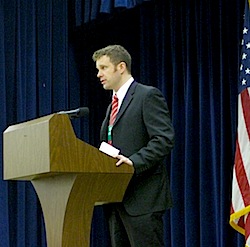 Association
of Atheists and Freethinkers, said humanist
chaplains would do everything religious chaplains do, including counsel
troops and help them follow their faiths. But just as a Protestant
chaplain would not preside over a Catholic service, a humanist might
not lead a religious ceremony, though he might help organize it. Association
of Atheists and Freethinkers, said humanist
chaplains would do everything religious chaplains do, including counsel
troops and help them follow their faiths. But just as a Protestant
chaplain would not preside over a Catholic service, a humanist might
not lead a religious ceremony, though he might help organize it.
“Humanism fills the same role for atheists that Christianity
does for Christians and Judaism does for Jews,” Mr. Torpy said
in an interview. “It answers questions of ultimate concern;
it directs our values.”
Mr. Torpy has asked to meet the chiefs of chaplains for each of the
armed forces, which have their own corps, to discuss his proposal.
The chiefs have yet to comment.
At the same time, an atheist group at Fort
Bragg called Military
Atheists and Secular Humanists, or
MASH, has asked the Army to appoint an atheist
lay leader at the base. A new MASH chapter at Fort
Campbell, Ky., is planning to do the same as are atheists
at MacDill Air Force Base in Florida.
Sgt. Justin Griffith,
28,
a communication sergeant at Fort Bragg
from 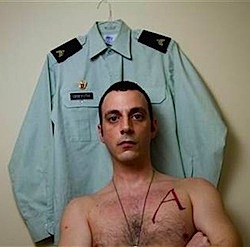 Dallas,
was a passionate Christian and creationist until his teens. Now his
dog tags list his religious preference as atheist, and he is pushing
to create MASH chapters on as many bases as possible. Dallas,
was a passionate Christian and creationist until his teens. Now his
dog tags list his religious preference as atheist, and he is pushing
to create MASH chapters on as many bases as possible.
He is also giving thought to becoming a chaplain himself, though it
would take years: He would have to earn a graduate degree in theology
and then be commissioned an officer. He would also need the endorsement
of “a qualified religious organization,” a role Mr. Torpy’s
organization is seeking to play.
Sergeant Griffith said he believed there
were already atheist chaplains in the military — just not open
ones.
Such lay leaders can lead “services”
in lieu of chaplains and have access to meeting rooms, including chapels.
  Chaplains
at Fort Bragg near here have seemed open to the idea, if somewhat
perplexed
by it. Chaplains
at Fort Bragg near here have seemed open to the idea, if somewhat
perplexed
by it.
“You’re not a faith group; you’re a lack-of-faith
group,” First Lt. Samantha Nicoll,
an active atheist at Fort Bragg, recalled a chaplain friend’s
saying about the idea. “But I said, ‘What else is there
for us?’”
Atheist leaders acknowledge the seeming
contradiction of nonbelievers
seeking to become chaplains or receive 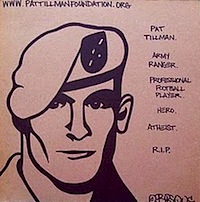 recognition
from the chaplain corps. But they say they believe the imprimatur
of the chaplaincy will embolden atheists who worry about being ostracized
for their worldviews. recognition
from the chaplain corps. But they say they believe the imprimatur
of the chaplaincy will embolden atheists who worry about being ostracized
for their worldviews.
Defense Department statistics show that
about 9,400 of the nation’s 1.4 million active-duty military
personnel identify themselves as atheists or agnostics, making
them a larger subpopulation than Jews, Muslims, Hindus or Buddhists
in the military.
But atheist leaders say those numbers are an undercount because, they
believe, there are many nonbelievers
among the 285,000 service members who claim no religious preference
on military surveys.
|
| 
ROSS
DOUTHAT
|
A
Case for Hell
By ROSS DOUTHAT
The New York Times: April 25, 2011
Here’s
a revealing snapshot of religion in America. On Easter Sunday, two
of the top three books on Amazon.com’s Religion and Spirituality
best-seller list mapped the geography of the afterlife. One was “Heaven
Is for Real: A Little Boy’s Astounding Story of His Trip to
Heaven and Back,” an account of a 4-year-old’s
near-death experience as dictated to his pastor father.
The other was “Love Wins: A Book
About Heaven, Hell, and the Fate of Every Person Who Ever Lived,”
in which the evangelical preacher Rob Bell  argues
that hell might not exist. argues
that hell might not exist.
In part, hell’s weakening grip on the religious imagination
is a consequence of growing pluralism. Bell’s book begins with
a provocative question: Are Christians
required to believe that Gandhi is in hell for being Hindu? The
mahatma is a distinctive case, but swap in “my Hindu/Jewish/Buddhist
neighbor” for Gandhi, and you can see why many religious Americans
find the idea of eternal punishment for wrong belief increasingly
unpalatable.
But the more important factor in hell’s eclipse, perhaps, is
a peculiar paradox of modernity. As our lives have grown longer and
more comfortable, our sense of outrage at human suffering —
its scope, and its apparent randomness — has grown sharper as
well. The argument that a good deity couldn’t have made a world
so rife with cruelty is a staple of atheist polemic, and every natural
disaster inspires a round of soul-searching over how to reconcile
with God’s omnipotence with human anguish.
These debates ensure that earthly infernos get all the press. Hell
means the Holocaust, the suffering in Haiti, and all the ordinary
“hellmouths” (in the novelist Norman Rush’s resonant
phrase) that can open up beneath our feet. And if it’s hard
for the modern mind to understand why a good God would allow such
misery on a temporal scale, imagining one who allows eternal suffering
seems not only offensive but absurd.
Atheists have license to scoff at damnation, but to believe in God
and not in hell is ultimately to disbelieve in the reality of human
choices. If there’s no possibility of saying
no to paradise then none of our no’s have any real meaning either.
|
| 

DAVID
BROOKS

|
Creed
or Chaos
By DAVID BROOKS
The New York Times: April 22, 2011
You can feel a jolt of energy surge through the
audience of “The Book of Mormon”
about a quarter of the way into the show’s first musical number.
It’s a jolt of joy, gratitude and laughter — a confirmation
that this  Broadway
production is going to live up to its rave reviews. Broadway
production is going to live up to its rave reviews.
The jolts keep coming and the audience I was part of rose up at the
end with a raucous standing ovation of the sort I’ve rarely seen.
There are four musical numbers that are truly fantastic, and the rest
of the show is clever, fast and surprisingly warm. The play is about
Mormon missionaries who find themselves in an AIDS-ravaged, warlord-dominated
region in Uganda. It ridicules Mormonism but not the Mormons, who are
loopy but ultimately admirable.
The central theme of “The Book of
Mormon” is that many religious stories are silly — the idea
that God would plant golden plates in upstate New York. Many religious
doctrines are rigid and out of touch.
But religion itself can do enormous good as long as people take religious
teaching metaphorically and not literally; as long as people understand
that all religions ultimately preach love and service underneath their
superficial particulars; as long as people practice their faiths open-mindedly
and are tolerant of different beliefs.
This warm theme infuses the play with humanity and compassion. It also
plays very well to an educated American audience. Many Americans have
always admired the style of belief that is spiritual but not doctrinal,
pluralistic and not exclusive, which offers tools for serving the greater
good but is not marred by intolerant theological judgments.
The only problem with “The Book
of Mormon” (you realize when thinking about it later) is
that its theme is not quite true. Vague, uplifting, nondoctrinal religiosity
doesn’t actually last. The religions that grow, succor and motivate
people to perform heroic acts of service are usually theologically rigorous,
arduous in practice and definite in their convictions about what is
True and False.
That’s because people are not gods. No matter how special
some individuals may think they are, they don’t have the ability
to understand the world on their own, establish rules of good conduct
on their own, impose the highest standards of conduct on their own,
or avoid the temptations of laziness on their own.
The religions that thrive have exactly what “The Book of Mormon”
ridicules: communal theologies, doctrines and codes of conduct rooted
in claims of absolute truth.
The Book of Mormon” is not anti-religious. It just endorses a
no-sharp-edges view of religion that is all creative metaphors and no
harsh judgments. The Africans in the play embrace this kind of religion.
And in the context of a hilarious musical, that’s fine.
But it’s worth remembering that the religions that thrive in real-life
Africa are not as nice and naïve as the religion in the play. The
religions thriving in real-life Africa are often so doctrinaire and
so socially conservative that they would make Pat Robertson’s
hair stand on end. |
| 
NIQAB
/ BURQA
|
France
Enforces Ban on Full-Face Veils in Public
By STEVEN ERLANGER
The New York Times: April 12, 2011
VÉNISSIEUX, France — France
on Monday formally banned the wearing of full  veils
in public places, becoming the first country in Europe to impose restrictions
on a form of attire that some Muslims consider a religious obligation. veils
in public places, becoming the first country in Europe to impose restrictions
on a form of attire that some Muslims consider a religious obligation.
The ban, which came after a year of debate and months of preparation,
is viewed by supporters as a necessary
step to preserve French culture and to fight what they see as separatist
tendencies among Muslims. But the ban set off protests
in Paris and several other cities, and it has left many Muslims, including
those in this heavily immigrant community near Lyon, worried about their
rights as French citizens.
The police do not have the authority under
the law to remove full veils, only to fine or require citizenship lessons
for those who violate the new law.
 The
issue was set alight in April 2009 by André
Gérin, then the Communist mayor of Vénissieux.
Half of the town’s 60,000 residents are non-French citizens or
their French-born children, and the niqab has been a relatively normal
sight here. Mr. Gérin said at the time that
the full facial veil, which is known in France erroneously
as the burqa, should be banned
in the name of the liberty and equality of women in a secular country. The
issue was set alight in April 2009 by André
Gérin, then the Communist mayor of Vénissieux.
Half of the town’s 60,000 residents are non-French citizens or
their French-born children, and the niqab has been a relatively normal
sight here. Mr. Gérin said at the time that
the full facial veil, which is known in France erroneously
as the burqa, should be banned
in the name of the liberty and equality of women in a secular country.
On Monday, in his office, Mr. Gérin
said the burqa was “just
the tip of the iceberg” of the spread of Muslim radicalism and
separatism that threatened the French Republic.
The law does not mention Islam or women.
It bans the covering of the face 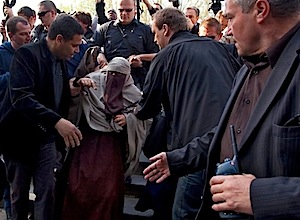 in
any public place, including shops and the street, as a security measure.
A clause says that anyone who forces a woman to cover her face can be
imprisoned for up to a year and fined
up to 30,000 euros, about $43,000. in
any public place, including shops and the street, as a security measure.
A clause says that anyone who forces a woman to cover her face can be
imprisoned for up to a year and fined
up to 30,000 euros, about $43,000.
But the law is “a point of departure,” said Mr. Gérin,
who retired as mayor but remains a member of the National
Assembly. Speaking of
young Muslim women who refuse to participate in school sports, or Muslim
men who refuse to allow a male doctor to treat their wives or who allegedly
compel their wives to wear the veil, Mr. Gérin called the law
“a wake-up call,” a means “to eradicate this minority
of fundamentalists, ‘the gurus’ who instrumentalize Islam
for political reasons.”
Polls show that the law is broadly popular
in France, and it passed the lower house of Parliament
with only one vote opposed. |
| 
MICHAEL
CREAMER
Faculty Advisor
Rutherford High
Atheist Club
|
Teenagers
Speak Up for Lack of Faith
By MICHAEL WINERIP
The New York Times: April 3, 2011
PANAMA
CITY, Fla. — Every other Wednesday, right after school
at 2:45, the  newest
club at Rutherford High, the atheist
club, meets in Room 13-211. newest
club at Rutherford High, the atheist
club, meets in Room 13-211.
Last Wednesday, Jim Dickey, the president,
started out by asking his fellow student atheists (there
are a few agnostics, too) whether they wanted to put
together an all-atheist Ultimate Frisbee team for a charity event.
“We can pay the entry fee from the club treasury,” said
Michael Creamer, the atheists’
faculty adviser, who urged them to take part.
Club members discussed what to do about Faith
Week. Rutherford High’s two Christian
clubs will be sponsoring a series of before-school prayer circles
around the flagpole this
week, and several of the atheists felt a need to respond in some way.
“We can set up informational tables near the flagpole and do
our own speeches,” said Mr. Creamer, who suggested waiting a
few weeks. “Remember, we’re not trying to be confrontational;
this will be a counterpoint.”
Mr. Creamer, 47, an English teacher
and longtime atheist who grew up in a family of Free Will Baptists,
is constantly urging club members to “be friendly, put on those
smiles — people don’t expect that from atheists.”
The Christians and atheists at Rutherford High get along better than
some might expect. Joshua Mercer, a
senior, who is president of Ignite, a Christian club,
and Jim, the atheist president,
are close friends. They love comparing philosophies, and giving each
other a hard time.
Still, he worries about Jim and the
other atheists. “If they don’t accept
Jesus Christ as a savior, they will definitely go to hell,”
said Joshua, who rises at 4:30 each morning to read the Bible
with his grandmother.
Joshua believes there is still time for Jim. “Jim
could change,” he said. “If
he will accept Jesus in his heart, he has a free ride to heaven.”
There have long been college atheist clubs.... But recently they have
been springing up at high schools.
Long
before there was an atheist club, Mr. Creamer was open about his atheism.
And yet as Joshua, the Christian club
president, says, “He lets you know what he believes, but I’ve
never seen him try to convert anyone.”
Mr. Creamer teaches his students that if they are going to stick out
their necks for unconventional ideas, they better not stick out for
any of the wrong reasons. “Mr.
Creamer told us, as an atheist, you have to be on your best behavior,”
said Nick Machuca, a junior.
Last
fall, Breane Lyga joined both a Christian
club and the atheist club.  Some
Christian club members thought she was doing it for a goof. Others
wondered if she was a spy for the atheists, but Breane said she was
just confused. Some
Christian club members thought she was doing it for a goof. Others
wondered if she was a spy for the atheists, but Breane said she was
just confused.
“I was kind of agnostic,”
she said. “I wanted to get both points of view.” She talked
with Mrs. Harrell and Mr. Creamer, two of her favorite teachers. She
weighed the pluses and minuses. Around Christmas she stopped attending
the Christian club meetings.
“I
guess I found out who I was,” she said.
|
| 
DANIEL
ABRAMS

RICHARD WIENER
|
Religion
may become extinct in nine nations
By Jason Palmer
Science and technology reporter
BBC News: 22 March 2011
A study using census data from nine countries
shows that religion there is set for extinction, say researchers.
The study found a steady rise in those claiming no religious affiliation.
 The
team's mathematical model attempts to account for the interplay between
the number of religious respondents and the social motives behind being
one. The
team's mathematical model attempts to account for the interplay between
the number of religious respondents and the social motives behind being
one.
The result, reported at the American
Physical Society meeting in Dallas, US, indicates that religion
will all but die out altogether in those countries.
The team took census data stretching back as far as a century from countries
in which the census queried religious affiliation:
Australia, Austria, Canada, the Czech Republic, Finland, Ireland, the
Netherlands, New Zealand and Switzerland.
Their means of analysing the data invokes what is known as nonlinear
dynamics - a mathematical approach that
has been used to explain a wide range of physical phenomena in which
a number of factors play a part.
One of the team, Daniel Abrams of Northwestern
University, put forth a similar model in 2003 to put
a numerical basis behind the decline of 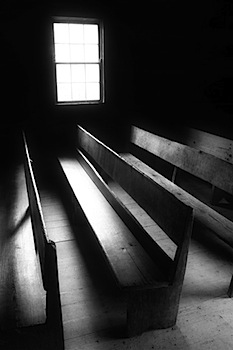 lesser-spoken
world languages. lesser-spoken
world languages.
"The idea is pretty simple," said Richard
Wiener of the Research Corporation for Science Advancement,
and the University of Arizona.
"It posits that social groups that have more members are going
to be more attractive to join, and it posits that social groups have
a social status or utility.
Dr Wiener continued: "In a large
number of modern secular democracies, there's been a trend that folk
are identifying themselves as non-affiliated with religion; in the Netherlands
the number was 40%, and the highest we saw was in
the Czech Republic, where the number was 60%."
The team then applied their nonlinear dynamics model, adjusting parameters
for the relative social and utilitarian merits of membership of the
"non-religious" category.
They found, in a study published online, that those parameters were
similar across all the countries studied, suggesting that similar behaviour
drives the mathematics in all of them.
And in all the countries, the indications
were that religion was headed toward extinction. |
| 
RONALD A. LINDSAY
CFi
President
& CEO
|
Center
For Inquiry
launches ad campaign about living
without religion
examiner.com: March 1st, 2011
 The
Center
For Inquiry
(CFi)
today launched a nationwide multimedia campaign to deliver the message
that it is possible to live a fulfilling life without God. From their
headquarters in Amherst, New York,
CFi
announced plans to deploy the ad campaign in three American cities. The
Center
For Inquiry
(CFi)
today launched a nationwide multimedia campaign to deliver the message
that it is possible to live a fulfilling life without God. From their
headquarters in Amherst, New York,
CFi
announced plans to deploy the ad campaign in three American cities.
Beginning today, there are ads on 15 buses and at two metro stations
in  the
Washington D.C. area. The bus ads and billboards
state the
Washington D.C. area. The bus ads and billboards
state
"You don't
need God - to hope, to care, to love, to live."
“With this campaign, we are aiming
to dispel some myths about the nonreligious,”
said Ronald A. Lindsay, CFi
president & CEO. “One
common myth is that the nonreligious lead empty, meaningless, selfish,
self-centered lives. This is not only false, it’s ridiculous.
Unfortunately, all too many people accept this myth because that’s
what they hear about nonbelievers.”
The campaign selected Washington D.C.,
Indianapolis, and Houston as the three cities in which
to roll out the initial ad blitz.
“Most everyone in the United States knows someone who is not
religious, whether they’re aware of this or not,” observed
Lindsay.
“We’re your friends, neighbors,
and colleagues-and we have similar hopes and concerns. Irrational
prejudice against nonbelievers has no place in twenty-first-century
America.”
Center For Inquiry
is a nonprofit organization with the mission to foster a secular society
based on science, reason, freedom of inquiry, and humanist values.
CFI has branches all over the world, with 19 here in the United States.
The local CFi
branch here in Portland, Oregon is one of the most
active and productive. CFi
events locally include meetups, book readings, lectures, and training
opportunites. For more information, see
the CFi
Portland website.
The website of the ad campaign, ,
contains more information about what CFi
hopes to accomplish. ,
contains more information about what CFi
hopes to accomplish.
CFi
is joining the list of secular organizations who have decided it is
high time to begin to counter the negative perceptions many people
have against freethinkers, and to let people who have lost faith know
there are places they can go to learn more and to share their experiences.
Faith has been dwindling in much of the world for years, and today
one in six Americans join that trend in not identifying with any religion.
While not all of them are atheists,
it's a good bet many who do proclaim a particular religious affiliation
are actually skeptics.
The number of freethinkers
may be larger than some polls indicate.

Click
√
on image for video
|
| 
ERIC
HOLDER
Attorney General

PRESIDENT
BARACK OBAMA

PRESIDENT
BILL CLINTON
|
Mr.
Obama Moves Against Bias
EDITORIAL
The New York Times: February 24, 2011
In a heartening reversal, President
Obama has instructed the Justice
Department to stop defending the constitutionality
of the Defense of Marriage Act.
That deplorable 1996 law sanctioned blatant discrimination against
the spousal rights of married gays and lesbians.
The announcement by Attorney General
Eric Holder Jr. struck at the core 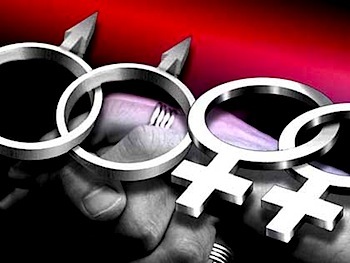 of
the matter, concluding that Congress had violated constitutional due
process in a debate rife with “moral
disapproval” of gay men and lesbians — “precisely
the kind of stereotype-based thinking and animus” banned by
the equal protection clause. of
the matter, concluding that Congress had violated constitutional due
process in a debate rife with “moral
disapproval” of gay men and lesbians — “precisely
the kind of stereotype-based thinking and animus” banned by
the equal protection clause.
The decision reversed the administration’s untenable position
of defending the law’s affront to equal rights even as Mr. Obama
made clear his personal opposition. Instead, Mr. Holder said it was
no longer possible to advance “hypothetical rationales”
in court independent of the bias-steeped record of Congressional enactment.
The act, passed in an election year and signed by President
Bill Clinton, arbitrarily denied federal benefits
for married couples to married same-sex couples, including Social
Security survivor payments and the option to file joint tax returns.
It allowed states to refuse to recognize same-sex marriages that are
legally recognized in other states.
The president’s decision is a major advancement for protecting
the rights of gay, lesbian, bisexual and transgender Americans. It
firmly skewers what has been bad law and complements the recent Congressional
repeal of the government’s “don’t ask, don’t
tell” prejudice suffered by gay men and lesbians serving the
nation in the military.
The administration said its revised position was in part because of
the fact that current court challenges require a rigorous enforcement
standard — “heightened scrutiny” — in the
case of protecting minority groups who have suffered a clear history
of official discrimination. The courts will still be the ultimate
arbiter of the law, but it is vital that the administration dropped
its commitment to press wrongheaded defenses. Congress may still pursue
its own brief in the courts.
The reversal seems likely to redound into the next election cycle
— a fight very much worth having. As a candidate three years
ago, Mr. Obama opposed the defense of marriage law but would not endorse
same-sex marriage, instead supporting civil unions for gay and lesbian
couples. In December, Mr. Obama said his feelings on the subject were
“constantly evolving.” Wednesday’s decision raises
the hope that they are evolving in the right direction — equal
rights for all Americans.
Meanwhile, it is stirring that the president has done the right thing
on the marriage law. He has scored Congress’s shabby violation
of constitutional rights that supposedly protect all Americans, not
just a selected majority in an election year.
Illustration:
AP
(Full
editorial)
|
| 
KATHLEEN
SEBELIUS
Secretary
of Health and Human Services
|
A
Bush
Rule on Providers of Abortions Is Revised
By ROBERT PEAR
The
New York Times: February 18, 2011
WASHINGTON — The Obama
administration on Friday rescinded most of a  2008
rule that granted sweeping protections to health care providers who
opposed abortion, sterilization and other medical procedures on religious
or moral grounds. 2008
rule that granted sweeping protections to health care providers who
opposed abortion, sterilization and other medical procedures on religious
or moral grounds.
Kathleen Sebelius, the secretary of
health and human services, said the rule,
issued in the last days of the Bush administration,
could “negatively impact
patient access to contraception and certain other medical services.”
Federal laws make clear that health care providers cannot be compelled
to perform or assist in an abortion, Ms. Sebelius said. The Bush rule
went far beyond these laws and upset the balance between patients’
rights to obtain health care and “the conscience rights of health
care providers,” she added.
The Obama administration retained and updated part of the 2008 rule
that established procedures to investigate complaints from health
care workers who believe they have been subjected to discrimination
or  coercion
because of their “religious beliefs or moral convictions.” coercion
because of their “religious beliefs or moral convictions.”
The
Roman Catholic Church and some Republicans,
like Representative Joe Pitts of Pennsylvania(left),
criticized the Obama administration’s decision to revoke the
Bush rule. But advocates for abortion rights welcomed it.


“The administration’s action today is cause for disappointment,”
said Deirdre A. McQuade,
a spokeswoman for the Pro-Life Secretariat
at the United States Conference of Catholic
Bishops.
|
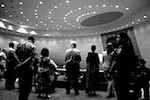
HAWAII
SENATE
in peayer |
Hawaii:
After Complaint, Senate Stops Praying
THE ASSOCIATED PRESS:
January 21, 2011
Fearing a possible court challenge, the State Senate has voted to
silence the daily prayer offered before each session. A citizen’s
complaint had prompted the American Civil Liberties Union last summer
to send the Senate a letter noting that its invocations often referenced
Jesus, contravening the separation of church and state. A committee
evaluated the issue and recommended allowing nonsectarian invocations
that avoided references to deities, but the Senate decided to do away
with prayers altogether rather than constrain them.
(Full
article)
|

GOV.
ROBERT BENTLEY
Alabama |
Alabama:
Governor Apologizes for Excluding Non-Christians
THE ASSOCIATED PRESS:
January 20, 2011
Gov. Robert Bentley
apologized Wednesday for his inauguration day remarks about
only Christians being his brothers and sisters and said he would work
for people of all faiths. Mr. Bentley said he was speaking as an evangelical
Christian to fellow Baptists when he made the comments from a church
pulpit during a Martin Luther King Day event. “If anyone from
other religions felt disenfranchised by the language, I want to say
I am sorry,” he said. Governor Bentley, a Republican, told the
church crowd just moments into his new administration: “Anybody
here today who has not accepted Jesus Christ as their savior, I’m
telling you, you’re not my brother and you’re not my sister,
and I want to be your brother.”
(Full
article)
|
| 
MAUREEN
DOWFD

KEVIN DOWD
|
My
Magi: Crab, Crocodile and Sea Horse
By MAUREEN DOWD, OP-ED COLUMNIST
The New York Times: December 22, 2010
Last Christmas I got a jolt.
I learned that my brother Kevin collects
crèches. They were all
over his house, crammed onto every mantle, table, counter, lawn and
closet — 17 in all, including the modest plastic stable our mom
put over the fireplace when we were little.
I was perturbed. I knew Kevin, a salesman, was a fanatical guardian
of the word Christmas, as opposed to the pagan, generic “holiday,”
but I had no idea that he had such a monomaniacal hobby.
Maybe I was scarred by reading “The Glass Menagerie” as
a teenager. But books and records aside, collections always struck me
as vaguely creepy. I had shuddered for years as my sister accumulated
clowns and Don Quixote objets. And the porcelain baby collection of
an older cousin actually made me feel queasy.
I wondered why Kevin was so obsessive about crèches. Was it a
way to stay close to our late mother? An homage to our old church, Nativity?
As a child, he treated St. Joseph, the shepherds and three kings as
action figures, staging smack downs. “The shepherd had an advantage
because he was holding the lamb, and he could use it as a weapon,”
Kevin recalled fondly.
I also remembered that he got very upset one year when St. Joseph was
stolen from the outdoor Nativity scene at Nativity, and he fretted over
why Christ’s stepfather disappeared from the New Testament so
abruptly. Could that make him hoard a houseful of St. Josephs —
and send his three sons to a college named St. Joseph’s?
I was curious enough about the manger mania that when he told me he’d
been invited to the Friends of the Creche annual convention in New Haven
one weekend in November, I asked if I could go, too.
Touring the crèche display at the Knights
of Columbus hall, we met collectors who had 300, 500, even 600
crèches, the kind who might put an addition on the house just
to display their stables. Kevin began to feel inadequate with a mere
15. (He gave two to his oldest son.)
Bonnie Psanenstiel, a heavyset 52-year-old nurse from Owensboro, Ky.,
told me that she has more than 500 sets packed into her “Nativity
meditation room,” even though “I’m not really into
religion.”
Father Tim Goldrick, the gregarious pastor
of St. Nicholas Church in Fall River, Mass.,
said his grandfather told him it was a Portuguese-Azorian tradition
that the man of the house set up the crèche. He begged to put
up their Woolworth’s set.
For years, the priest kept hundreds of crèches in milk crates
in his guest room, which precluded actual guests.
“There was no room in the inn,” he said wryly.
Father Tim explained to Kevin that Joseph might have disappeared so
abruptly all those years ago because of the belief that if you bury
a St. Joseph statue in the yard, you can sell your house quicker. (A
tradition that has revived with the recession,  according
to The Wall Street Journal.) according
to The Wall Street Journal.)
I couldn’t fight the fanatics, so I joined them. I bought a Cape
Cod crèche at the convention made by Nathaniel Wordell of South
Chatham, Mass. Mary’s a mermaid. The baby Jesus is covered with
a striped beach towel. The Wise Men are crab, crocodile and sea horse.
The “livestock” are frog, turtle and starfish. Joseph has
a trident.
Sadly, it did not draw my brother and me closer. “That is sacrilegious,”
Kevin said, staring in horror. “The Virgin Mary does not have
a tail.” |

GAIL
COLLINS
New Tork Times
Op-Ed Columnist

Senator
JAMES INHOFE
R
- 0K

GARY
BAUER
former Republcan Presidential candidate
|
My
Favorite War
By GAIL COLLINS
OP-ED COLUMNIST
The New York Times: December 11, 2010
Well, here’s some good news for
a change. The Holiday Parade of Lights in Tulsa, Okla., has been saved!
The Tulsa City Council has voted to allow
the parade to go forward Saturday night, despite protests against
the disappearance of the word “Christmas”
from its name.
It’s not entirely clear that the council
actually could have stopped it, or even whether the parade ever officially
had Christmas in its name. But Senator
James Inhofe of Oklahoma is outraged.
Inhofe was away from home last December, stuck in Washington trying
to kill off health care reform. Now he’s back, and he’s
noted a dwindling in the parade’s religious angle. “I
just don’t like what’s going on in America today, all
over the country, with the aversion some people seem to have toward
Christ,” he said in one of his many interviews explaining
that he will no longer ride his horse in any
holiday event that isn’t named for Christmas.
 Go to it, Senator Inhofe! I love this controversy, and only in part
because it diverts Oklahoma’s senior senator from his normal
day job of trying to convince the world that global warming doesn’t
exist.
Go to it, Senator Inhofe! I love this controversy, and only in part
because it diverts Oklahoma’s senior senator from his normal
day job of trying to convince the world that global warming doesn’t
exist.
We live in a time of so many terrifying, insurmountable problems.
It’s comforting to return to arguing about whether the nation’s
moral fiber is endangered if Tulsa downplays the religious aspects
of a parade full of Santa Clauses that is currently sponsored by a
popular downtown pub.
Actually, the “war on Christmas”
controversy has been a little muted this year, and I’ve missed
it. Even the public hearing in Tulsa looked thinly attended, as if
the issue at hand was charter revision instead of the preservation
of the Christian half of our Judeo-Christian heritage.
The American Family Association is still
checking up on major retailers and informing us that while Bed
Bath & Beyond is “for Christmas,”
Foot Locker is “against.” And a coalition of concerned
clergy in Fort Worth is calling residents
to boycott the transit system because someone purchased ads on four
buses that say “Millions of Americans
Are Good Without God.”
It is my impression that people who ride buses in Texas don’t
have a whole lot of other options. Really, concerned clergy, do you
think they’re doing it to cut their carbon footprints?
But until Tulsa, the biggest conflict was here in the New York area,
where a billboard war erupted after the American
Atheists forked over $20,000 for a sign that showed a picture
of a Nativity scene and the message: “You
know it’s a myth. This Season, Celebrate Reason!”
The Catholic League then erected one
on the other side of the Lincoln Tunnel that retorts: “You
Know It’s Real. This Season, Celebrate Jesus.”
In this battle for the hearts and minds of commuters,
the atheists seem to have been overly belligerent, although it is
understandable that they get a little testy this time of year.
If you complain
about Christmas overkill because you are, say, a Muslim or a Jew,
the general response is a quick hug and a nervous affirmation that
all faiths deserve respect. But atheists do not get that
many hugs, and perhaps it is beginning to tell on them.
We are still enjoying the continuing fights about What
To Call The Tree. In one of the most notable screeds of the
season, Gary Bauer, the former
Republican presidential candidate and social conservative,
appeared to be saying that officials in Portland, Ore., who named
the annual tree-lighting ceremony “Tree
Lighting” were doing the work of the would-be Christmas
tree bomber. “Radical Islam’s secular
enablers have been driving Christianity from the public square for
decades,” he wrote.
Bauer said in a phone interview that he was not suggesting that trying
to blow up downtown Portland and secularizing the tree lighting were
equivalent.
“To me, it was just a nice rhetorical way to get people to read
the column,” he said.
I am in sympathy with such sentiments since I would do just about
everything short of bomb threats to get people to read a column. I
also have a soft spot in my heart for Bauer and I am sorry he is not
planning to run for president again in 2012 because the moment he
fell off the platform during a preprimary pancake flipping contest
in New Hampshire was one of my personal campaign high points.
But about Tulsa. For years the parade was sponsored
by the American Electric Power-Public Service Company of Oklahoma,
which is mercifully known as P.S.O. “We always referred to it
as the P.S.O. Parade of Lights,” a spokesman for the
utility told The Tulsa World. When
P.S.O. backed out, a downtown pub named McNellie’s agreed to
underwrite the Holiday Parade of Lights. You’d think people
would be grateful that the new sponsor didn’t want to call it
the Happy Hour Parade of Lights, or Atomic Chicken Wings Special.
But no.
Keep fighting. I haven’t thought about the Bush tax cuts for
hours.
(Full
text)
|
| 
NICHOLAS
KRISTOF
|
Test
Your Savvy on Religion
By NICHOLAS D. KRISTOF
The New York Times: October 9, 2010
The New York Times
reported recently on a Pew Research Center poll
 in
which religious people turned out to be remarkably uninformed about
religion. Almost half of Catholics didn’t
understand Communion. Most Protestants didn’t know that
Martin Luther started the Reformation.
Almost half of Jews didn’t realize Maimonides
was Jewish. And Atheists were among the best
informed about religion. in
which religious people turned out to be remarkably uninformed about
religion. Almost half of Catholics didn’t
understand Communion. Most Protestants didn’t know that
Martin Luther started the Reformation.
Almost half of Jews didn’t realize Maimonides
was Jewish. And Atheists were among the best
informed about religion.

So let me give everybody another chance. And given the uproar about
Islam, I’ll focus on extremism and fundamentalism — and,
as you’ll see, there’s a larger point to this quiz.
Note
that some questions have more than one correct choice.
1. Which holy book stipulates that a girl who
does not bleed on her wedding night should be stoned to death?
a. Koran
b. Old Testament
c. (Hindu) Upanishads
2. Which holy text declares: “Let there
be no compulsion in religion”?
a. Koran
b. Gospel of Matthew
c. Letter of Paul to the Romans
3. The terrorists who pioneered the suicide
vest in modern times, and the use of women in terror attacks, were
affiliated with which major religion?
a. Islam
b. Christianity
c. Hinduism
4. "Every child is touched by the devil
as soon as he is born and this contact makes him cry. Excepted are
Mary and her Son.” This verse is from:
a. Letters of Paul to the Corinthians
b. The Book of Revelation
c. An Islamic hadith, or religious tale
5. Which holy text is sympathetic to slavery?
a. Old Testament
b. New Testament
c. Koran
6. In the New Testament, Jesus’ views
of homosexuality are:
a. strongly condemnatory
b. forgiving
c. never mentioned
7. Which holy text urges responding to evil
with kindness, saying: “repel the evil deed with one which is
better.”
a. Gospel of Luke
b. Book of Isaiah
c. Koran
8. Which religious figure preaches tolerance by suggesting that God
looks after all peoples and leads them all to their promised lands?
a. Muhammad
b. Amos
c. Jesus
9. Which of these religious leaders was a polygamist?
a. Jacob
b. King David
c. Muhammad
10. What characterizes Muhammad’s behavior
toward the Jews of his time?
a. He killed them.
b. He married one.
c. He praised them as a chosen people.
11. Which holy scripture urges that the "little
ones" of the enemy be dashed against the stones?
a. Book of Psalms
b. Koran
c. Leviticus
12. Which holy scripture suggests beating wives
who misbehave?
a. Koran
b. Letters of Paul to the Corinthians
c. Book of Judges
13. Which religious leader is quoted as commanding
women to be silent during services?
a. The first Dalai Lama
b. St. Paul
c. Muhammad
For
answers, click √
on Kristof image
Click √
on image above for full survey |
|
|
|
|
|
|







 packed
into a stadium on Sunday to denounce the Shabab
Islamist group for the suicide bombing last week that killed
scores of people, many of them students.
packed
into a stadium on Sunday to denounce the Shabab
Islamist group for the suicide bombing last week that killed
scores of people, many of them students.  “Should
we abandon our country because of fugitive criminals from abroad and
children who have disobeyed their parents?” asked President
Sheik Sharif Sheik Ahmed (right).
“The answer is no.”
“Should
we abandon our country because of fugitive criminals from abroad and
children who have disobeyed their parents?” asked President
Sheik Sharif Sheik Ahmed (right).
“The answer is no.” people
were soaked in sweat by the time they walked from their neighborhoods
to the old soccer stadium, located in central Mogadishu. The program
included speeches and traditional Somali dances. Many people seemed
deeply moved.
people
were soaked in sweat by the time they walked from their neighborhoods
to the old soccer stadium, located in central Mogadishu. The program
included speeches and traditional Somali dances. Many people seemed
deeply moved.

 The
national battle was ignited in July by Stuart
Wilber, a 73-year-old gay man in Seattle. He
was astonished, he said, when he learned that people who bought Microsoft
products through a Christian-oriented Internet marketer known as Charity
Giveback Group, or CGBG, could channel a donation to evangelical organizations
that call homosexual behavior a threat to the moral and social fabric.
The
national battle was ignited in July by Stuart
Wilber, a 73-year-old gay man in Seattle. He
was astonished, he said, when he learned that people who bought Microsoft
products through a Christian-oriented Internet marketer known as Charity
Giveback Group, or CGBG, could channel a donation to evangelical organizations
that call homosexual behavior a threat to the moral and social fabric.
 and
presidential contender, who is a paid CGBG consultant.
“To try to destroy a business because you don’t like some
of the customers is, to me, unbelievably un-American,” he said
in an interview.
and
presidential contender, who is a paid CGBG consultant.
“To try to destroy a business because you don’t like some
of the customers is, to me, unbelievably un-American,” he said
in an interview.  that
would make it illegal for such centers to advertise falsely about their
pregnancy-related services, something already more broadly covered by
a state law barring deceptive advertising. But
the bill’s author, Malia Cohen (right),
said the law was necessary to protect low-income women who are
drawn into the centers, which often offer free services.
that
would make it illegal for such centers to advertise falsely about their
pregnancy-related services, something already more broadly covered by
a state law barring deceptive advertising. But
the bill’s author, Malia Cohen (right),
said the law was necessary to protect low-income women who are
drawn into the centers, which often offer free services. office
had written to a local center, First Resort,
about its advertisements, which he said “appear
to be designed to confuse or mislead consumers.”
In a letter to the center’s chief
office
had written to a local center, First Resort,
about its advertisements, which he said “appear
to be designed to confuse or mislead consumers.”
In a letter to the center’s chief
 executive,
Shari Plunkett (right),
Mr. Herrera asked that the ads be corrected to
make clear that the center does not perform abortions or make referrals
for them.
executive,
Shari Plunkett (right),
Mr. Herrera asked that the ads be corrected to
make clear that the center does not perform abortions or make referrals
for them.

 mourners
at the World Trade Center site seized
upon a cross-shaped steel beam found amid the rubble as a symbol of
faith and hope.
mourners
at the World Trade Center site seized
upon a cross-shaped steel beam found amid the rubble as a symbol of
faith and hope. government
financed and is on government property, the cross’s inclusion
in the museum violates the United States Constitution and state civil
rights law. The lawsuit, in turn, provoked the ire of
the American Center for Law and Justice, a conservative public interest
law firm, as well as others.
government
financed and is on government property, the cross’s inclusion
in the museum violates the United States Constitution and state civil
rights law. The lawsuit, in turn, provoked the ire of
the American Center for Law and Justice, a conservative public interest
law firm, as well as others. Jewish
Committee and has long studied church-state issues,
said the lawsuit presented “an
extra-difficult case.”
Jewish
Committee and has long studied church-state issues,
said the lawsuit presented “an
extra-difficult case.” “plausible.”
The outcome, he said, could depend on how the beam was displayed when
the museum opened.
“plausible.”
The outcome, he said, could depend on how the beam was displayed when
the museum opened. “The
challenged cross constitutes an unlawful attempt to promote a specific
religion
on governmental land,” the lawsuit charged.
“The
challenged cross constitutes an unlawful attempt to promote a specific
religion
on governmental land,” the lawsuit charged.

 the
First Amendment’s establishment clause.
the
First Amendment’s establishment clause. despite
the harrowing testimony of many of the accusers. A report by a commission
set up by the church said last year that 13 people were believed to
have committed suicide as a result of sexual abuse by clerics.
despite
the harrowing testimony of many of the accusers. A report by a commission
set up by the church said last year that 13 people were believed to
have committed suicide as a result of sexual abuse by clerics. Lieve
Halsberghe, who represents the Survivors Network of Those Abused
by Priests, criticized the fact that the church was
expected to be represented on the adjudication panel. “They
can’t be the accused and the judge at the same time,”
she said.
Lieve
Halsberghe, who represents the Survivors Network of Those Abused
by Priests, criticized the fact that the church was
expected to be represented on the adjudication panel. “They
can’t be the accused and the judge at the same time,”
she said. in
the evolution of the American family toward less traditional forms.
in
the evolution of the American family toward less traditional forms.
 Broadway
production is going to live up to its rave reviews.
Broadway
production is going to live up to its rave reviews. veils
in public places, becoming the first country in Europe to impose restrictions
on a form of attire that some Muslims consider a religious obligation.
veils
in public places, becoming the first country in Europe to impose restrictions
on a form of attire that some Muslims consider a religious obligation. The
issue was set alight in April 2009 by André
Gérin, then the Communist mayor of Vénissieux.
Half of the town’s 60,000 residents are non-French citizens or
their French-born children, and the niqab has been a relatively normal
sight here. Mr. Gérin said at the time that
the full facial veil, which is known in France erroneously
as the burqa, should be banned
in the name of the liberty and equality of women in a secular country.
The
issue was set alight in April 2009 by André
Gérin, then the Communist mayor of Vénissieux.
Half of the town’s 60,000 residents are non-French citizens or
their French-born children, and the niqab has been a relatively normal
sight here. Mr. Gérin said at the time that
the full facial veil, which is known in France erroneously
as the burqa, should be banned
in the name of the liberty and equality of women in a secular country. in
any public place, including shops and the street, as a security measure.
A clause says that anyone who forces a woman to cover her face can be
imprisoned for up to a year and fined
up to 30,000 euros, about $43,000.
in
any public place, including shops and the street, as a security measure.
A clause says that anyone who forces a woman to cover her face can be
imprisoned for up to a year and fined
up to 30,000 euros, about $43,000. The
team's mathematical model attempts to account for the interplay between
the number of religious respondents and the social motives behind being
one.
The
team's mathematical model attempts to account for the interplay between
the number of religious respondents and the social motives behind being
one. lesser-spoken
world languages.
lesser-spoken
world languages.
 according
to The Wall Street Journal.)
according
to The Wall Street Journal.)








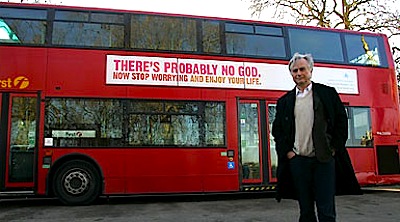

 the
concept of heaven is a "fairy story" for people who fear death.
the
concept of heaven is a "fairy story" for people who fear death.



 In
a run-down maternity hospital in Jakarta’s gritty exurbs recently,
the shooting of “Evil Nurse 2,”
a sequel to a low-budget horror film, proceeded under unusually tight
secrecy.
In
a run-down maternity hospital in Jakarta’s gritty exurbs recently,
the shooting of “Evil Nurse 2,”
a sequel to a low-budget horror film, proceeded under unusually tight
secrecy.
 they
are, but they won’t admit it. It’s a love-hate thing.”
they
are, but they won’t admit it. It’s a love-hate thing.” in
Jakarta, the controversy showed that for many Indonesians, Miyabi —
as Indonesians popularly know Ms. Ozawa — was already a household
name. Films starring her (“Kidnapping
Miyabi”) and another
Japanese porn star, Rin Sakuragi (right,
“Evil Nurse”), have been resounding successes.
in
Jakarta, the controversy showed that for many Indonesians, Miyabi —
as Indonesians popularly know Ms. Ozawa — was already a household
name. Films starring her (“Kidnapping
Miyabi”) and another
Japanese porn star, Rin Sakuragi (right,
“Evil Nurse”), have been resounding successes.












 religion,
YOU
WILL ALL GO TO HELL. Since there is more than one of these
religions and since people do not belong to more than one religion,
we can project that all souls go to Hell.
With birth and death rates as they are, we can
expect the number of souls in Hell to increase exponentially.
religion,
YOU
WILL ALL GO TO HELL. Since there is more than one of these
religions and since people do not belong to more than one religion,
we can project that all souls go to Hell.
With birth and death rates as they are, we can
expect the number of souls in Hell to increase exponentially. that,
'It will be a cold day in Hell before I sleep
with you,' and take into account the fact that I slept with
her last night, then number two must be true, and thus I am sure that
Hell is exothermic and has already frozen over.
that,
'It will be a cold day in Hell before I sleep
with you,' and take into account the fact that I slept with
her last night, then number two must be true, and thus I am sure that
Hell is exothermic and has already frozen over. The
corollary of this theory is that since Hell has frozen over, it follows
that it is not accepting any more souls and is therefore, extinct.....
.....leaving only Heaven, thereby proving the existence of a divine
being which explains why, last night, Teresa kept shouting,
The
corollary of this theory is that since Hell has frozen over, it follows
that it is not accepting any more souls and is therefore, extinct.....
.....leaving only Heaven, thereby proving the existence of a divine
being which explains why, last night, Teresa kept shouting, NEWS
IS ~
NEWS
IS ~ Catholic
priests — the first-ever trial of a diocesan
supervisor for allegedly covering up the scandal — has
opened in Philadelphia. The issue of
hierarchal responsibility is finally front and center.
Catholic
priests — the first-ever trial of a diocesan
supervisor for allegedly covering up the scandal — has
opened in Philadelphia. The issue of
hierarchal responsibility is finally front and center. secret
archive he compiled on predator priests that he said was ordered shredded
in 1994 by Cardinal Anthony Bevilacqua (right).
secret
archive he compiled on predator priests that he said was ordered shredded
in 1994 by Cardinal Anthony Bevilacqua (right). tried
to treat pedophile priests like alcoholics with “Sexaholics
Anonymous” programs.
tried
to treat pedophile priests like alcoholics with “Sexaholics
Anonymous” programs.
 many
of the other men on the hall. One had already
many
of the other men on the hall. One had already  begun
decorating. I spotted the poster above his desk
right away. It showed a loaf of bread and a chalice of red wine, with
these words: “Jesus invites you to a banquet
in his honor.”
begun
decorating. I spotted the poster above his desk
right away. It showed a loaf of bread and a chalice of red wine, with
these words: “Jesus invites you to a banquet
in his honor.” righteousness
sometimes abet. A teenage girl he met was dying of sepsis from
a female circumcision performed with a kitchen
knife. He asked the male medical worker attending to her why
such crude mutilation was condoned, and was told that women
otherwise were overly sexual and “prone
to prostitution.”
righteousness
sometimes abet. A teenage girl he met was dying of sepsis from
a female circumcision performed with a kitchen
knife. He asked the male medical worker attending to her why
such crude mutilation was condoned, and was told that women
otherwise were overly sexual and “prone
to prostitution.” he
said. “They feel so strongly about this that they
will attempt abortion even when it’s illegal,
unsafe and often lethal.”
he
said. “They feel so strongly about this that they
will attempt abortion even when it’s illegal,
unsafe and often lethal.” sometimes
wearing a bulletproof vest.
sometimes
wearing a bulletproof vest. That happened in a church, he noted.
He hasn’t belonged to one since college. “Religion
too often demands belief in physical absurdities and anachronistic
traditions despite all scientific evidence and moral progress,”
he said.
That happened in a church, he noted.
He hasn’t belonged to one since college. “Religion
too often demands belief in physical absurdities and anachronistic
traditions despite all scientific evidence and moral progress,”
he said. Siddhartha,
Gandhi, Marcus Aurelius, Martin Luther King
Siddhartha,
Gandhi, Marcus Aurelius, Martin Luther King  and
more. From the New Testament, too. He put each
on a strip of paper, then filled a salad bowl with the strips.
At dinner he asks his kids to fish one out so they can discuss it.
and
more. From the New Testament, too. He put each
on a strip of paper, then filled a salad bowl with the strips.
At dinner he asks his kids to fish one out so they can discuss it. “whore”
at every woman who walked into the clinic.
“whore”
at every woman who walked into the clinic.

 There
is one recent exception, and it deserves praise.
There
is one recent exception, and it deserves praise.  A
few days ago, the New Hampshire Legislature
voted overwhelmingly to keep a law that gives people of the same sex
the freedom to marry. Legislators decided,
in the kind of deliberation that stills the cynic in me,
that telling somebody whom they can or cannot marry is
the ultimate restriction on personal liberty. If your official
state motto is “Live Free or Die,”
you ought to act like you believe it.
A
few days ago, the New Hampshire Legislature
voted overwhelmingly to keep a law that gives people of the same sex
the freedom to marry. Legislators decided,
in the kind of deliberation that stills the cynic in me,
that telling somebody whom they can or cannot marry is
the ultimate restriction on personal liberty. If your official
state motto is “Live Free or Die,”
you ought to act like you believe it.






 advocacy
group that cut off most of its grants to Planned
Parenthood for breast cancer screening,
said Thursday that he would make up a large part of the missing money.
advocacy
group that cut off most of its grants to Planned
Parenthood for breast cancer screening,
said Thursday that he would make up a large part of the missing money.
 right-wing
political pressure campaigns.”
right-wing
political pressure campaigns.”

 world,
arising from the vulnerabilities of sentient beings and from the capacities
of rational beings to recognize and to respond to those vulnerabilities
and capacities in others.
world,
arising from the vulnerabilities of sentient beings and from the capacities
of rational beings to recognize and to respond to those vulnerabilities
and capacities in others.  Divine
Command Theory insists both that there is such a thing as moral goodness,
and that it is defined by what God commands. This makes for really
appalling
Divine
Command Theory insists both that there is such a thing as moral goodness,
and that it is defined by what God commands. This makes for really
appalling  consequences,
from an intuitive, moral point of view. Divine Command Theory entails
that anything at all could be “good” or “right”
or “wrong.” If God were to command you to eat your children,
then it would be “right” to eat your children.
consequences,
from an intuitive, moral point of view. Divine Command Theory entails
that anything at all could be “good” or “right”
or “wrong.” If God were to command you to eat your children,
then it would be “right” to eat your children. 
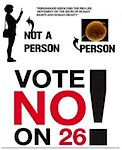
 in
Mississippi and a crackdown on voting rights in Maine.
in
Mississippi and a crackdown on voting rights in Maine. “The
message from Mississippi is clear,” Nancy
Keenan, president of NARAL Pro-Choice America, said in a statement.
“An amendment that allows politicians to further interfere in
our personal, private medical decisions, including a woman’s
right to choose safe, legal abortion, is unacceptable.”
“The
message from Mississippi is clear,” Nancy
Keenan, president of NARAL Pro-Choice America, said in a statement.
“An amendment that allows politicians to further interfere in
our personal, private medical decisions, including a woman’s
right to choose safe, legal abortion, is unacceptable.”
 The
Dutch branch of the Roman Catholic Church
will start a compensation system
The
Dutch branch of the Roman Catholic Church
will start a compensation system  that
clears the way for victims of abuse by priests and other church workers
to receive payments of up to $138,000, the church
announced Monday. The country’s
Bishops’ Conference and Conference
of Religious Orders said the system would probably take effect
next month. Thousands of cases of allegations of sexual
abuse by Dutch priests are under investigation by an independent,
church-financed commission.
that
clears the way for victims of abuse by priests and other church workers
to receive payments of up to $138,000, the church
announced Monday. The country’s
Bishops’ Conference and Conference
of Religious Orders said the system would probably take effect
next month. Thousands of cases of allegations of sexual
abuse by Dutch priests are under investigation by an independent,
church-financed commission. apologized
for a column that said that homosexuality is caused by Satan.
The column’s author, Daniel Avila,
is a lawyer and policy adviser at the Catholic
bishops’ conference in Washington, where he works in
the office that opposes the spread of same-sex marriage.
Mr. Avila wrote, “The
scientific evidence of how
apologized
for a column that said that homosexuality is caused by Satan.
The column’s author, Daniel Avila,
is a lawyer and policy adviser at the Catholic
bishops’ conference in Washington, where he works in
the office that opposes the spread of same-sex marriage.
Mr. Avila wrote, “The
scientific evidence of how  same-sex
attraction most likely may be created provides a credible basis for
a spiritual explanation that indicts the devil.”
The church’s Boston newspaper,
The Pilot, apologized for “having
failed to recognize the theological error in the column before publication,”
and it deleted the column from its Web site. A
spokeswoman for the bishops’ conference said that
Mr. Avila’s column was not approved by the bishops, and that
the church does not have a definitive theory on the origins of same-sex
attraction.
same-sex
attraction most likely may be created provides a credible basis for
a spiritual explanation that indicts the devil.”
The church’s Boston newspaper,
The Pilot, apologized for “having
failed to recognize the theological error in the column before publication,”
and it deleted the column from its Web site. A
spokeswoman for the bishops’ conference said that
Mr. Avila’s column was not approved by the bishops, and that
the church does not have a definitive theory on the origins of same-sex
attraction.  but
Deputy Prime Minister Eamon Gilmore (right)
said the decision was made on “purely economic grounds”
and not as a result of a rift with the Holy See over the handling
of allegations of child sexual abuse. Mr. Gilmore
said “recent controversies” had no bearing on the decision,
citing the government’s need to reduce expenses under the terms
of a European Union bailout package. The government is also closing
embassies in East Timor and Iran, he said. The
Vatican withdrew its ambassador to Ireland in July after an Irish
government report said the Vatican had discouraged bishops from reporting
cases of sexual abuse to the police, a charge the Vatican rejects.
The Vatican said Thursday that every state was “free to decide”
whether or not to have an envoy in Rome, but what counts are diplomatic
relations, “and these are not in question with regards to Ireland.”
but
Deputy Prime Minister Eamon Gilmore (right)
said the decision was made on “purely economic grounds”
and not as a result of a rift with the Holy See over the handling
of allegations of child sexual abuse. Mr. Gilmore
said “recent controversies” had no bearing on the decision,
citing the government’s need to reduce expenses under the terms
of a European Union bailout package. The government is also closing
embassies in East Timor and Iran, he said. The
Vatican withdrew its ambassador to Ireland in July after an Irish
government report said the Vatican had discouraged bishops from reporting
cases of sexual abuse to the police, a charge the Vatican rejects.
The Vatican said Thursday that every state was “free to decide”
whether or not to have an envoy in Rome, but what counts are diplomatic
relations, “and these are not in question with regards to Ireland.”
 indicted
for failure to report suspected child abuse, the first time in the
25-year history of the church’s sex abuse scandals that the
leader of an American diocese has been held criminally liable for
the behavior of a priest he supervised.
indicted
for failure to report suspected child abuse, the first time in the
25-year history of the church’s sex abuse scandals that the
leader of an American diocese has been held criminally liable for
the behavior of a priest he supervised. misdemeanor
count involving a priest accused of taking pornographic photographs
of girls as recently as this year. They pleaded not
guilty.
misdemeanor
count involving a priest accused of taking pornographic photographs
of girls as recently as this year. They pleaded not
guilty. Finn
acknowledged that he knew of the photographs last December but did
not turn them over to the police until May. During
that time, the priest, the
Rev. Shawn Ratigan, is said to have continued to attend church
events with children, and took lewd photographs of another young girl.
Finn
acknowledged that he knew of the photographs last December but did
not turn them over to the police until May. During
that time, the priest, the
Rev. Shawn Ratigan, is said to have continued to attend church
events with children, and took lewd photographs of another young girl. “This
is huge for us,” said Michael Hunter,
director of the Kansas City chapter of the Survivors
Network of those Abused by Priests, and a victim
of sexual abuse by a priest. “It’s something that I personally
have been waiting for years to see, some real accountability. We’re
very pleased with the prosecuting attorney here to have the guts to
do it.”
“This
is huge for us,” said Michael Hunter,
director of the Kansas City chapter of the Survivors
Network of those Abused by Priests, and a victim
of sexual abuse by a priest. “It’s something that I personally
have been waiting for years to see, some real accountability. We’re
very pleased with the prosecuting attorney here to have the guts to
do it.”


 December
but did not turn them over to the police until May.
December
but did not turn them over to the police until May.

 schools
it operated, a Roman
Catholic order said Thursday that it had settled a class-action
lawsuit by the victims with a $17 million
payment. In addition to the payment, the
Congregation of the Holy Cross issued
a formal apology. The
settlement covers incidents from 1950 to 2001, mostly at an elite
Montreal boarding school [College Notre-Dame] formerly run
by the order, which also controls the University of
Notre Dame in Indiana. A separate criminal investigation by the police
is continuing.
schools
it operated, a Roman
Catholic order said Thursday that it had settled a class-action
lawsuit by the victims with a $17 million
payment. In addition to the payment, the
Congregation of the Holy Cross issued
a formal apology. The
settlement covers incidents from 1950 to 2001, mostly at an elite
Montreal boarding school [College Notre-Dame] formerly run
by the order, which also controls the University of
Notre Dame in Indiana. A separate criminal investigation by the police
is continuing.

 lashes
for violating the country's ban on female drivers, according to <
Princess Amira al-Taweel,> wife of Saudi
Prince Alwaleed bin Talal.
lashes
for violating the country's ban on female drivers, according to <
Princess Amira al-Taweel,> wife of Saudi
Prince Alwaleed bin Talal. anonymity
because he was not authorized to talk to the media.
anonymity
because he was not authorized to talk to the media.
 without
offering further details.
without
offering further details. The
sentence took Saudi women by surprise, two days after King
Abdullah (right) announced that women would be allowed
to vote for the first time in 2015. However, there is no national
voting in Saudi Arabia. Furthermore, women
still do not have the right to vote or run as candidates in new municipal
elections on Thursday, the second in the kingdom's history. The first
were held in 2005.
The
sentence took Saudi women by surprise, two days after King
Abdullah (right) announced that women would be allowed
to vote for the first time in 2015. However, there is no national
voting in Saudi Arabia. Furthermore, women
still do not have the right to vote or run as candidates in new municipal
elections on Thursday, the second in the kingdom's history. The first
were held in 2005. “discrimination
against women in the kingdom.”
“discrimination
against women in the kingdom.” “Flogging
is a cruel punishment in all circumstances but it beggars belief that
the authorities in Saudi Arabia have imposed lashes on a woman apparently
for merely driving a car,” said
Philip Luther, the Amnesty's Middle East
and North Africa deputy director.
“Flogging
is a cruel punishment in all circumstances but it beggars belief that
the authorities in Saudi Arabia have imposed lashes on a woman apparently
for merely driving a car,” said
Philip Luther, the Amnesty's Middle East
and North Africa deputy director.


 countries,
perhaps nowhere have they shaken a whole society so thoroughly or
so intensely as in Ireland. And so when the normally mild-mannered
prime minister, Enda Kenny (right),
unexpectedly took the floor in Parliament this summer to criticize
the church, he was giving voice not just to his own
pent-up feelings, but to those of a nation.
countries,
perhaps nowhere have they shaken a whole society so thoroughly or
so intensely as in Ireland. And so when the normally mild-mannered
prime minister, Enda Kenny (right),
unexpectedly took the floor in Parliament this summer to criticize
the church, he was giving voice not just to his own
pent-up feelings, but to those of a nation. had
never before been used publicly by an Irish leader. The effect of
his speech was instant and electric.
had
never before been used publicly by an Irish leader. The effect of
his speech was instant and electric. There is no question that Mr. Kenny’s declaration deeply angered
the Vatican. It immediately withdrew
its ambassador from Dublin, Archbishop Giuseppe
Leanza (left),
ostensibly to help fashion the Vatican’s formal response. (The
ambassador has since been reassigned to the Czech Republic.)
There is no question that Mr. Kenny’s declaration deeply angered
the Vatican. It immediately withdrew
its ambassador from Dublin, Archbishop Giuseppe
Leanza (left),
ostensibly to help fashion the Vatican’s formal response. (The
ambassador has since been reassigned to the Czech Republic.)  defends
itself.
defends
itself.

 By
GAIA PIANIGIANI
By
GAIA PIANIGIANI


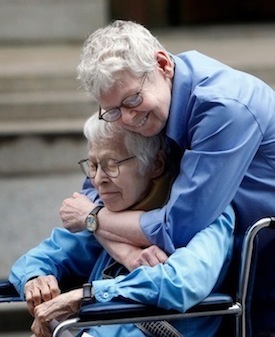
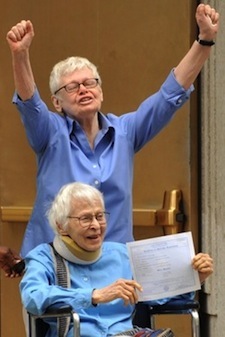


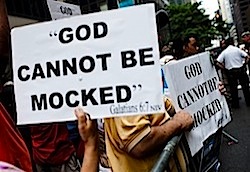



 that
limits the legal definition of marriage to a union between a man and
a woman, the White House said Tuesday, taking
another step in support of gay rights
that
limits the legal definition of marriage to a union between a man and
a woman, the White House said Tuesday, taking
another step in support of gay rights
 The
Obama administration said in February that it would no longer defend
the Defense of Marriage Act in legal proceedings, and Attorney
General Eric H. Holder Jr. said for the first time that Mr.
Obama believed the act was unconstitutional.
The
Obama administration said in February that it would no longer defend
the Defense of Marriage Act in legal proceedings, and Attorney
General Eric H. Holder Jr. said for the first time that Mr.
Obama believed the act was unconstitutional.


 Republican
from Buffalo who had sought office promising to oppose same-sex marriage,
told his colleagues he had agonized for months
before concluding he had been wrong.
Republican
from Buffalo who had sought office promising to oppose same-sex marriage,
told his colleagues he had agonized for months
before concluding he had been wrong.
 support
the marriage bill.
support
the marriage bill.
 those
that oppose same-sex weddings. On Friday, the
Assembly and the Senate approved those changes. But
they were not enough to satisfy the measure’s staunchest opponents.
In a joint statement, New York’s Catholic bishops assailed the
vote.
those
that oppose same-sex weddings. On Friday, the
Assembly and the Senate approved those changes. But
they were not enough to satisfy the measure’s staunchest opponents.
In a joint statement, New York’s Catholic bishops assailed the
vote.

 the
Bronx, the only Democratic senator to cast a no vote.
Mr. Díaz, saying
he was offended by the two-minute restrictions set on speeches, repeatedly
interrupted the presiding officer who tried to limit the senator’s
remarks, shouting, “You don’t want
to hear me.”
the
Bronx, the only Democratic senator to cast a no vote.
Mr. Díaz, saying
he was offended by the two-minute restrictions set on speeches, repeatedly
interrupted the presiding officer who tried to limit the senator’s
remarks, shouting, “You don’t want
to hear me.”



 gains
and losses of the past year.
gains
and losses of the past year. Michael
R. Bloomberg and the New York City Council
speaker, Christine C. Quinn, who is gay. But
there was little question that the governor was the parade’s
rock star, eliciting shrieks as he made his way down Fifth Avenue.
Michael
R. Bloomberg and the New York City Council
speaker, Christine C. Quinn, who is gay. But
there was little question that the governor was the parade’s
rock star, eliciting shrieks as he made his way down Fifth Avenue. summer.
“He’s been doing what he
said he’d do. A lot of past governors and even the president
haven’t come through. He did.”
summer.
“He’s been doing what he
said he’d do. A lot of past governors and even the president
haven’t come through. He did.” energy
and it’s always been a ball, but this was special,” the
governor said as he stepped out of the parade on Christopher Street.
“I think you’re going to see this
message resonate all across the country now. If New York can do it,
it’s O.K. for every other place to do it.”
energy
and it’s always been a ball, but this was special,” the
governor said as he stepped out of the parade on Christopher Street.
“I think you’re going to see this
message resonate all across the country now. If New York can do it,
it’s O.K. for every other place to do it.” In
a rare public appearance with the governor, Mr.
Cuomo’s
In
a rare public appearance with the governor, Mr.
Cuomo’s  girlfriend,
Sandra Lee (left with Gov. Cuomo),
a celebrity chef who has a gay brother, marched by his side. Ms.
Lee figured into Mr. Cuomo’s deliberations over same-sex marriage,
according to those who know the couple: she repeatedly reminded him
that she wanted the law
girlfriend,
Sandra Lee (left with Gov. Cuomo),
a celebrity chef who has a gay brother, marched by his side. Ms.
Lee figured into Mr. Cuomo’s deliberations over same-sex marriage,
according to those who know the couple: she repeatedly reminded him
that she wanted the law  changed.
changed.
 voted
for the bill [Senators
James S. Alesi, Mark
J. Grisanti, Stephen
M. Saland and Roy J. McDonald].
voted
for the bill [Senators
James S. Alesi, Mark
J. Grisanti, Stephen
M. Saland and Roy J. McDonald].
 New York State has made a powerful and
principled choice by giving all
New York State has made a powerful and
principled choice by giving all  couples
the right to wed and enjoy the legal rights of marriage. It
is a proud moment for New Yorkers, thousands
of whom took to the streets on Sunday to celebrate this step forward.
But this moment does not erase the
bigotry against gays and lesbians enshrined in the federal Defense
of Marriage Act, which denies federal recognition of same-sex
marriages and allows any state to refuse to recognize another state’s
unions.
couples
the right to wed and enjoy the legal rights of marriage. It
is a proud moment for New Yorkers, thousands
of whom took to the streets on Sunday to celebrate this step forward.
But this moment does not erase the
bigotry against gays and lesbians enshrined in the federal Defense
of Marriage Act, which denies federal recognition of same-sex
marriages and allows any state to refuse to recognize another state’s
unions. couples
during an appeal.
couples
during an appeal. Party
and Catholics whose church leaders opposed his successful
push last week to legalize gay marriage.
Party
and Catholics whose church leaders opposed his successful
push last week to legalize gay marriage. Wednesday
in Houston seeking to stop an evangelical
Christian prayer event next month that is endorsed by Gov.
Rick Perry. In its lawsuit, the Freedom
from Religion Foundation
argues that Mr. Perry’s day of prayer and fasting would violate
the constitutional ban on government endorsement of a religion.
The event, which is called the Response
and is billed as Christian-only, is scheduled for Aug. 6 at Reliant
Stadium in Houston. The group, which unsuccessfully
sued to stop a national day of prayer earlier this year, filed the
case on behalf of 700 members in Texas and called on the court to
stop Mr. Perry, a Republican who is contemplating a presidential run,
from participating in the meeting or using his office to promote or
recognize it. A spokeswoman for Mr.
Perry said the lawsuit would not change his plans.
Wednesday
in Houston seeking to stop an evangelical
Christian prayer event next month that is endorsed by Gov.
Rick Perry. In its lawsuit, the Freedom
from Religion Foundation
argues that Mr. Perry’s day of prayer and fasting would violate
the constitutional ban on government endorsement of a religion.
The event, which is called the Response
and is billed as Christian-only, is scheduled for Aug. 6 at Reliant
Stadium in Houston. The group, which unsuccessfully
sued to stop a national day of prayer earlier this year, filed the
case on behalf of 700 members in Texas and called on the court to
stop Mr. Perry, a Republican who is contemplating a presidential run,
from participating in the meeting or using his office to promote or
recognize it. A spokeswoman for Mr.
Perry said the lawsuit would not change his plans.



 circumcision
in San Francisco last
fall, many people simply brushed them aside. Even in that liberal
seaside city, it seemed implausible
that thousands of people would support an effort to outlaw an ancient
ritual that Jews and Muslims believe fulfills a commandment issued
by God.
circumcision
in San Francisco last
fall, many people simply brushed them aside. Even in that liberal
seaside city, it seemed implausible
that thousands of people would support an effort to outlaw an ancient
ritual that Jews and Muslims believe fulfills a commandment issued
by God. November
2012.
November
2012.
 elsewhere
but here, we’re safe and we’re secure.”
elsewhere
but here, we’re safe and we’re secure.” boys
who is promoting the ballot measure
in Santa Monica, said she views her work as a chance
to educate would-be parents against
a procedure that “can really do serious damage to the child.”
boys
who is promoting the ballot measure
in Santa Monica, said she views her work as a chance
to educate would-be parents against
a procedure that “can really do serious damage to the child.”

 the
Anti-Defamation League, said
the comic relied on anti-Semitic imagery.
the
Anti-Defamation League, said
the comic relied on anti-Semitic imagery.

 and
Rebecca Wyland sat next to each other — ramrod
straight, their shoulders barely touching — as they watched
images of their daughter flash on the screen.
and
Rebecca Wyland sat next to each other — ramrod
straight, their shoulders barely touching — as they watched
images of their daughter flash on the screen.

 Alayna
was found to have a hemangioma, a benign tumor that may cause blindness
if it grows around the eye.
Alayna
was found to have a hemangioma, a benign tumor that may cause blindness
if it grows around the eye. The
church first came under criticism in 1998 after the local news media
reported that of the 78 children buried
in the church’s graveyard ['baby row'], at least 21 could have
survived if they had received medical attention.
The
church first came under criticism in 1998 after the local news media
reported that of the 78 children buried
in the church’s graveyard ['baby row'], at least 21 could have
survived if they had received medical attention.

 Although
the Lord is frequently invoked during sex, belief
in religion puts a damper on one's sex life, according to a
new study.
Although
the Lord is frequently invoked during sex, belief
in religion puts a damper on one's sex life, according to a
new study. 14,000
people conducted by psychologist Darrel
Ray (below
left)and Kansas University researcher Amanda
Brown.
14,000
people conducted by psychologist Darrel
Ray (below
left)and Kansas University researcher Amanda
Brown.

 Witnesses,
Pentecostal Christians, Seventh Day Adventists and Baptists.
Witnesses,
Pentecostal Christians, Seventh Day Adventists and Baptists.
 once
people leave religion, their enjoyment of sex seems to greatly increase,"
Ray said. "That's what they told us, anyway."
once
people leave religion, their enjoyment of sex seems to greatly increase,"
Ray said. "That's what they told us, anyway." "Those
raised with religion reported feeling
"Those
raised with religion reported feeling  incredibly
guilty about
masturbation -- the guilt
scores were just off the charts,”
Ray said. “One respondent told
me, ‘If I masturbated under the covers,
I thought God couldn’t see me,'
but afterwards I still prayed for forgiveness.”
incredibly
guilty about
masturbation -- the guilt
scores were just off the charts,”
Ray said. “One respondent told
me, ‘If I masturbated under the covers,
I thought God couldn’t see me,'
but afterwards I still prayed for forgiveness.” much
impact on the amount of masturbation and premarital sex, however.
much
impact on the amount of masturbation and premarital sex, however.



 4.
In the Bible, erotic writing is:
4.
In the Bible, erotic writing is:

 Professor
Knust’s point is that the Bible’s teachings about sexuality
are murky and inconsistent and prone to being hijacked by ideologues
(this quiz involves some cherry-picking of my own).
Professor
Knust’s point is that the Bible’s teachings about sexuality
are murky and inconsistent and prone to being hijacked by ideologues
(this quiz involves some cherry-picking of my own). 

 massive
earthquakes didn’t rock the entire Earth. The righteous didn’t
rise up to heaven as 6 p.m. struck in timezones all over the world,
and trumpets
didn’t sound to mark the start of Armageddon.
massive
earthquakes didn’t rock the entire Earth. The righteous didn’t
rise up to heaven as 6 p.m. struck in timezones all over the world,
and trumpets
didn’t sound to mark the start of Armageddon.



 officials
confirmed Wednesday that the initiative had received enough signatures
to appear on the ballot, getting more than 7,700 valid signatures from
city residents. Initiatives must receive at least 7,168 signatures to
qualify. If the measure passes, circumcision would be prohibited among
males under the age of 18. The practice would become a misdemeanor offense
punishable by a fine of up to $1,000 or up to one year in jail. There
would be no religious exemptions. The initiative appears to be the first
of its kind in the country to actually make it to this stage, though
a larger national debate over the health benefits of circumcision has
been going on for many years.
officials
confirmed Wednesday that the initiative had received enough signatures
to appear on the ballot, getting more than 7,700 valid signatures from
city residents. Initiatives must receive at least 7,168 signatures to
qualify. If the measure passes, circumcision would be prohibited among
males under the age of 18. The practice would become a misdemeanor offense
punishable by a fine of up to $1,000 or up to one year in jail. There
would be no religious exemptions. The initiative appears to be the first
of its kind in the country to actually make it to this stage, though
a larger national debate over the health benefits of circumcision has
been going on for many years.

 But
with more and more people now saying they have no religion, one college
has decided to be the first to offer a major in secularism. Starting
this fall, Pitzer College, a small liberal
arts institution in Southern California, will inaugurate a department
of secular studies.
But
with more and more people now saying they have no religion, one college
has decided to be the first to offer a major in secularism. Starting
this fall, Pitzer College, a small liberal
arts institution in Southern California, will inaugurate a department
of secular studies. 
 The percentage of American adults who
say they have no religion has doubled in 20 years, to 15 percent,
according to the American Religious
Identification Survey, released in 2008. The survey
was conducted by researchers at Trinity College in Hartford, which
houses the Institute for the Study of
Secularism, Society and Culture but does not have
a distinct major in secular studies.
Barry A. Kosmin (left), the director of the institute,
said Pitzer College would be the first to have such a major.
The percentage of American adults who
say they have no religion has doubled in 20 years, to 15 percent,
according to the American Religious
Identification Survey, released in 2008. The survey
was conducted by researchers at Trinity College in Hartford, which
houses the Institute for the Study of
Secularism, Society and Culture but does not have
a distinct major in secular studies.
Barry A. Kosmin (left), the director of the institute,
said Pitzer College would be the first to have such a major.


 who
minister to the spiritual and emotional needs of active duty troops,
regardless of their faiths. The vast majority are Christians, a few
are Jews or Muslims, one is a Buddhist. A Hindu, possibly even a Wiccan
may join their ranks soon.
who
minister to the spiritual and emotional needs of active duty troops,
regardless of their faiths. The vast majority are Christians, a few
are Jews or Muslims, one is a Buddhist. A Hindu, possibly even a Wiccan
may join their ranks soon. Association
of Atheists and Freethinkers, said humanist
chaplains would do everything religious chaplains do, including counsel
troops and help them follow their faiths. But just as a Protestant
chaplain would not preside over a Catholic service, a humanist might
not lead a religious ceremony, though he might help organize it.
Association
of Atheists and Freethinkers, said humanist
chaplains would do everything religious chaplains do, including counsel
troops and help them follow their faiths. But just as a Protestant
chaplain would not preside over a Catholic service, a humanist might
not lead a religious ceremony, though he might help organize it. Dallas,
was a passionate Christian and creationist until his teens. Now his
dog tags list his religious preference as atheist, and he is pushing
to create MASH chapters on as many bases as possible.
Dallas,
was a passionate Christian and creationist until his teens. Now his
dog tags list his religious preference as atheist, and he is pushing
to create MASH chapters on as many bases as possible.
 Chaplains
at Fort Bragg near here have seemed open to the idea, if somewhat
perplexed
by it.
Chaplains
at Fort Bragg near here have seemed open to the idea, if somewhat
perplexed
by it. recognition
from the chaplain corps. But they say they believe the imprimatur
of the chaplaincy will embolden atheists who worry about being ostracized
for their worldviews.
recognition
from the chaplain corps. But they say they believe the imprimatur
of the chaplaincy will embolden atheists who worry about being ostracized
for their worldviews.
 argues
that hell might not exist.
argues
that hell might not exist.


 newest
club at Rutherford High, the atheist
club, meets in Room 13-211.
newest
club at Rutherford High, the atheist
club, meets in Room 13-211. Some
Christian club members thought she was doing it for a goof. Others
wondered if she was a spy for the atheists, but Breane said she was
just confused.
Some
Christian club members thought she was doing it for a goof. Others
wondered if she was a spy for the atheists, but Breane said she was
just confused.


 The
Center
For Inquiry
(CFi)
today launched a nationwide multimedia campaign to deliver the message
that it is possible to live a fulfilling life without God. From their
headquarters in Amherst, New York,
CFi
announced plans to deploy the ad campaign in three American cities.
The
Center
For Inquiry
(CFi)
today launched a nationwide multimedia campaign to deliver the message
that it is possible to live a fulfilling life without God. From their
headquarters in Amherst, New York,
CFi
announced plans to deploy the ad campaign in three American cities. the
Washington D.C. area. The bus ads and billboards
state
the
Washington D.C. area. The bus ads and billboards
state



 of
the matter, concluding that Congress had violated constitutional due
process in a debate rife with “moral
disapproval” of gay men and lesbians — “precisely
the kind of stereotype-based thinking and animus” banned by
the equal protection clause.
of
the matter, concluding that Congress had violated constitutional due
process in a debate rife with “moral
disapproval” of gay men and lesbians — “precisely
the kind of stereotype-based thinking and animus” banned by
the equal protection clause.
 2008
rule that granted sweeping protections to health care providers who
opposed abortion, sterilization and other medical procedures on religious
or moral grounds.
2008
rule that granted sweeping protections to health care providers who
opposed abortion, sterilization and other medical procedures on religious
or moral grounds. coercion
because of their “religious beliefs or moral convictions.”
coercion
because of their “religious beliefs or moral convictions.”






 Go to it, Senator Inhofe! I love this controversy, and only in part
because it diverts Oklahoma’s senior senator from his normal
day job of trying to convince the world that global warming doesn’t
exist.
Go to it, Senator Inhofe! I love this controversy, and only in part
because it diverts Oklahoma’s senior senator from his normal
day job of trying to convince the world that global warming doesn’t
exist. in
which religious people turned out to be remarkably uninformed about
religion. Almost half of Catholics didn’t
understand Communion. Most Protestants didn’t know that
Martin Luther started the Reformation.
Almost half of Jews didn’t realize Maimonides
was Jewish. And Atheists were among the best
informed about religion.
in
which religious people turned out to be remarkably uninformed about
religion. Almost half of Catholics didn’t
understand Communion. Most Protestants didn’t know that
Martin Luther started the Reformation.
Almost half of Jews didn’t realize Maimonides
was Jewish. And Atheists were among the best
informed about religion.






